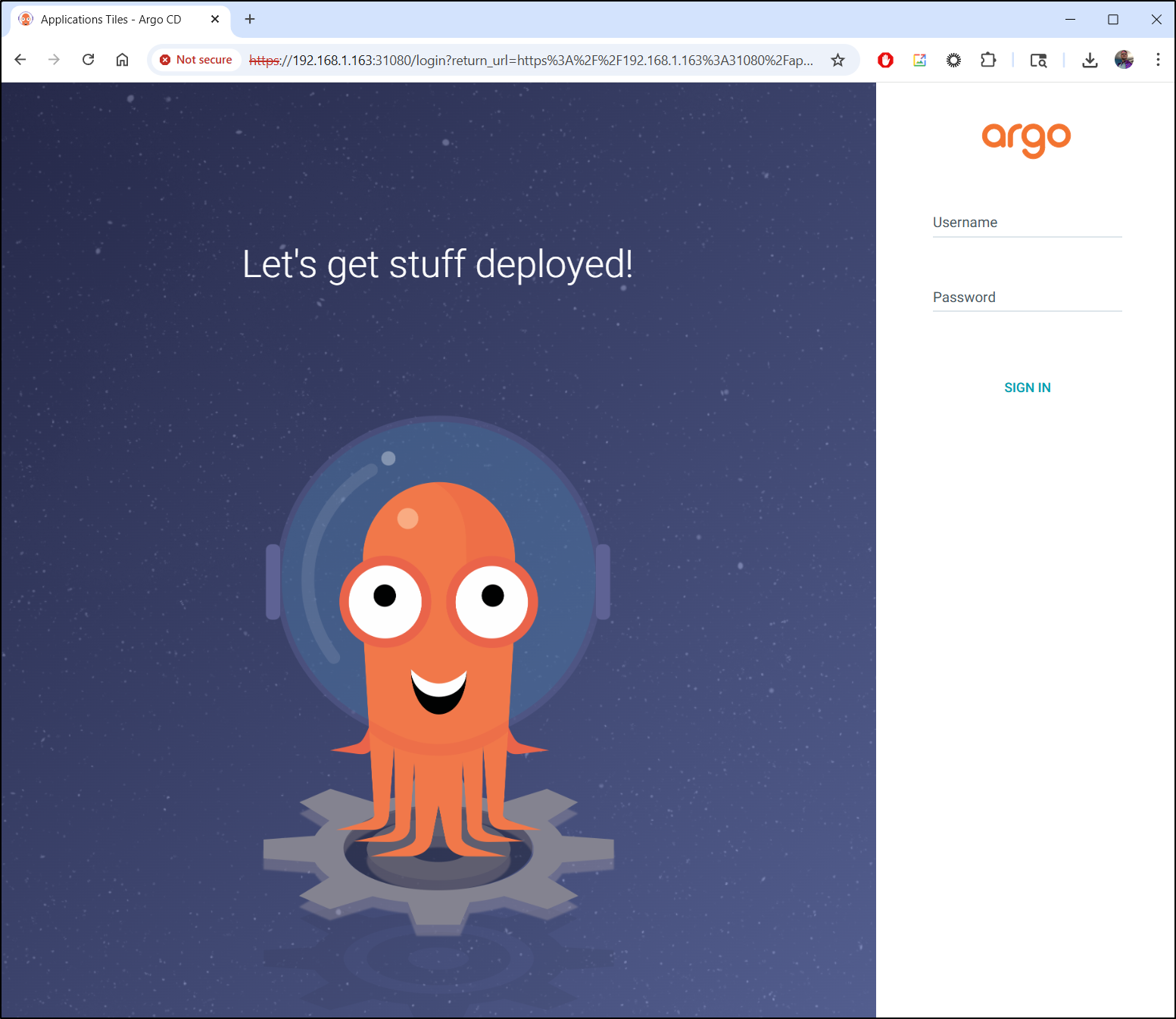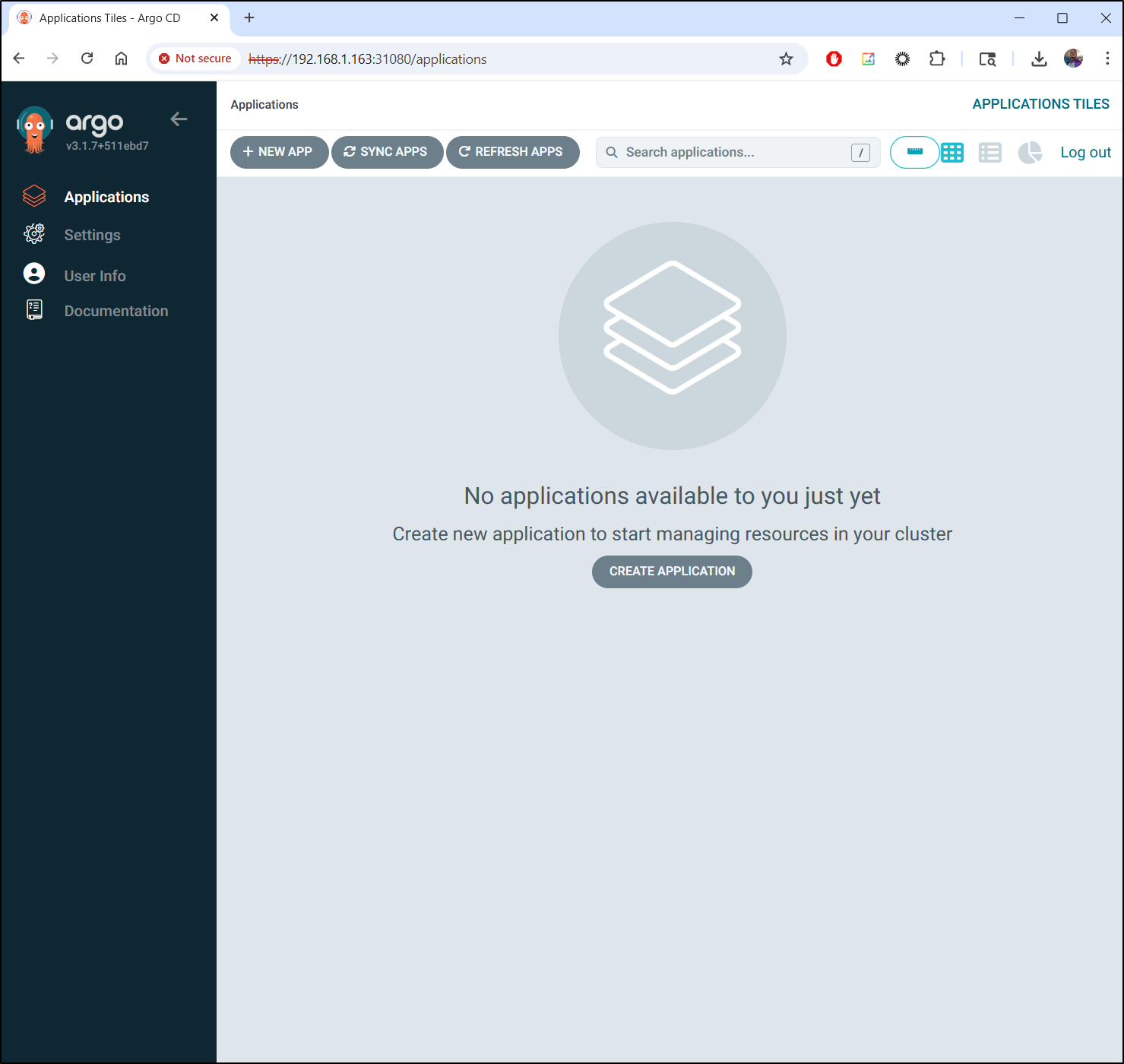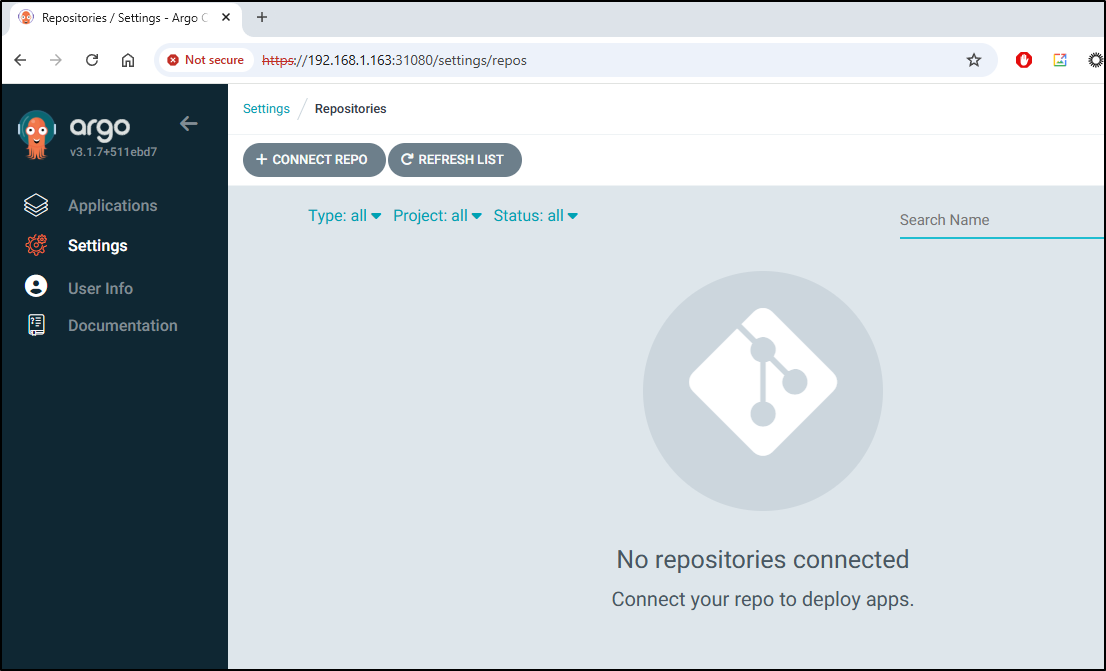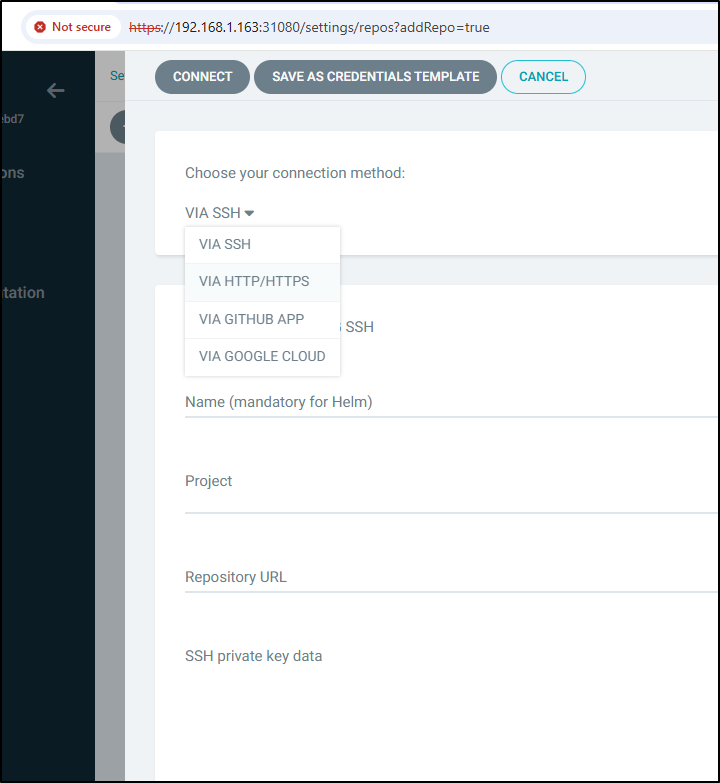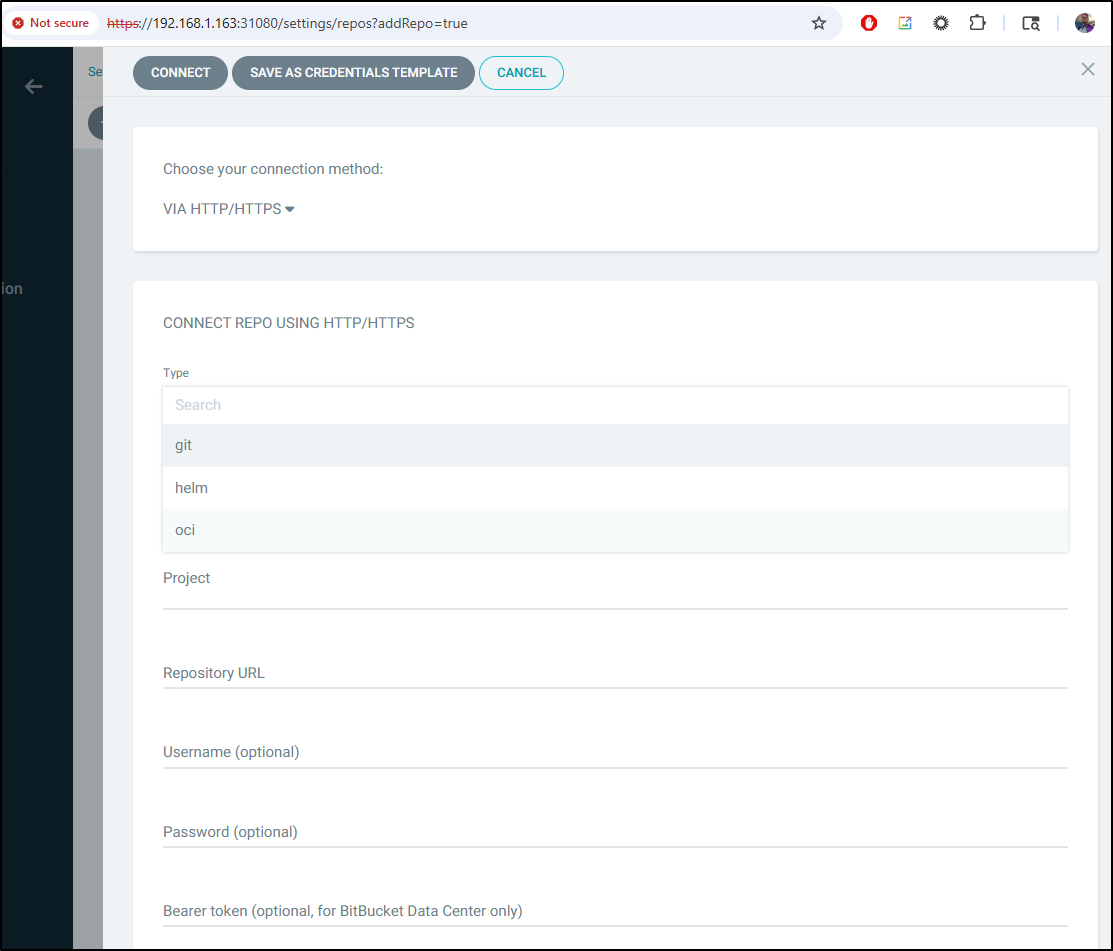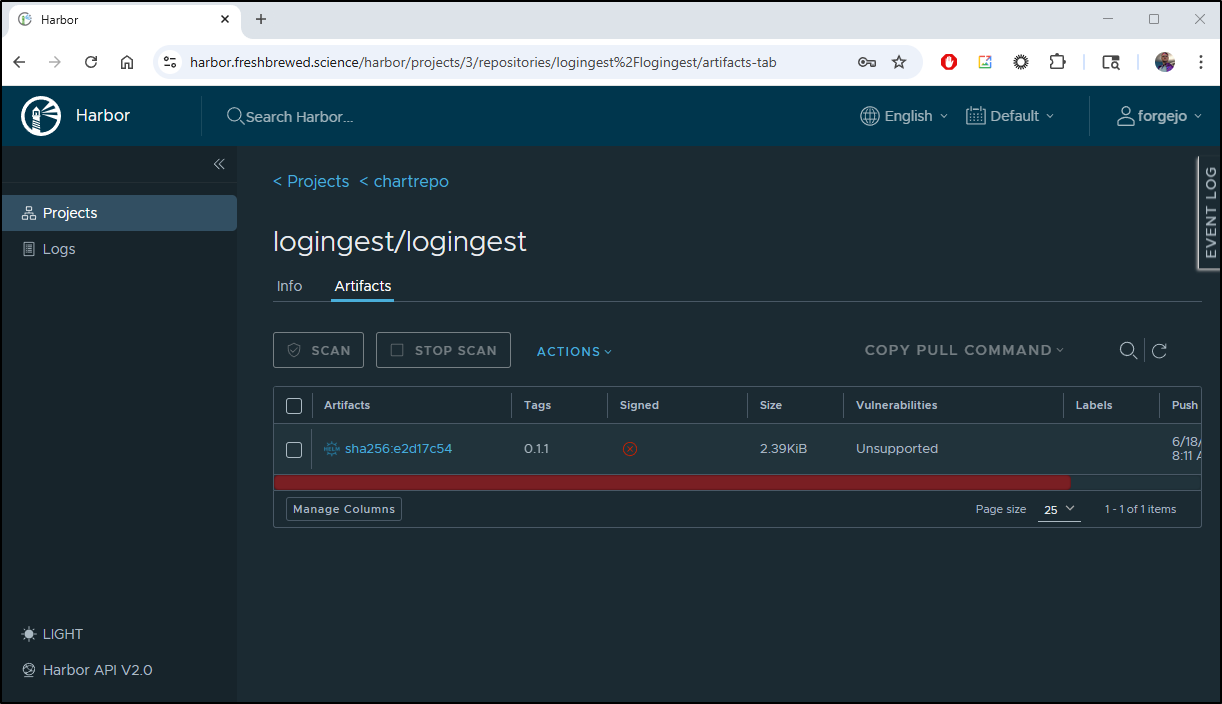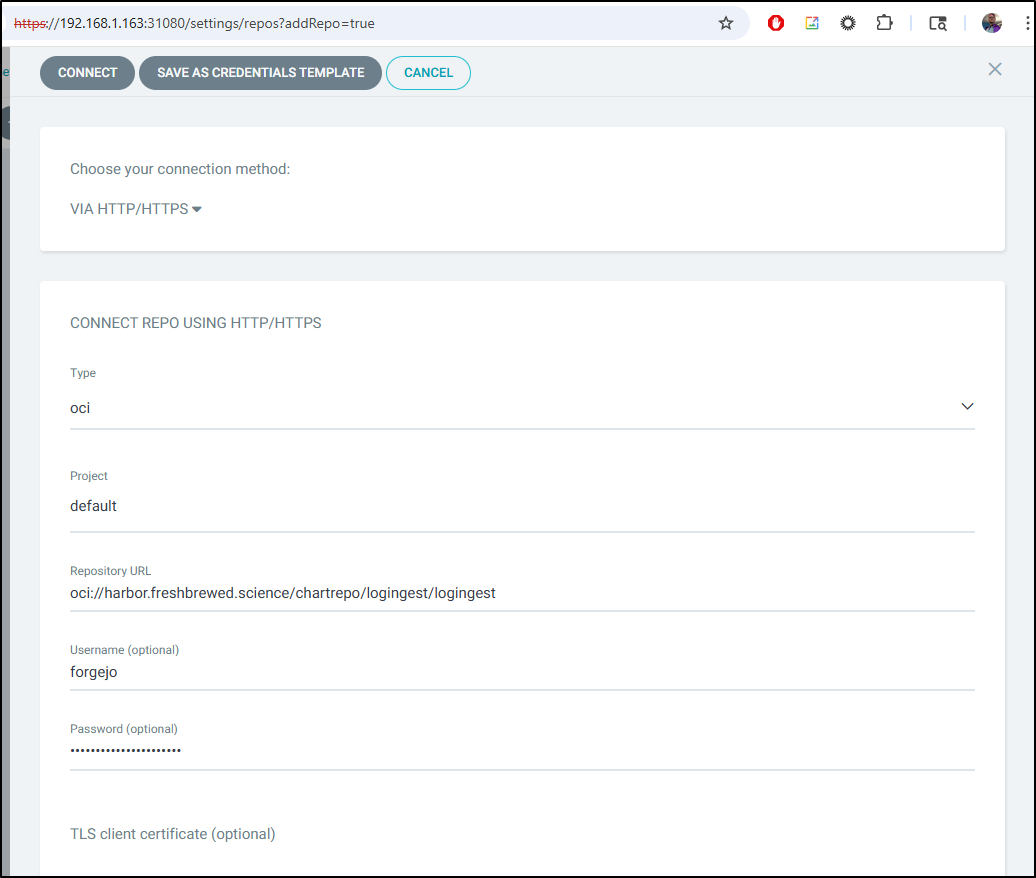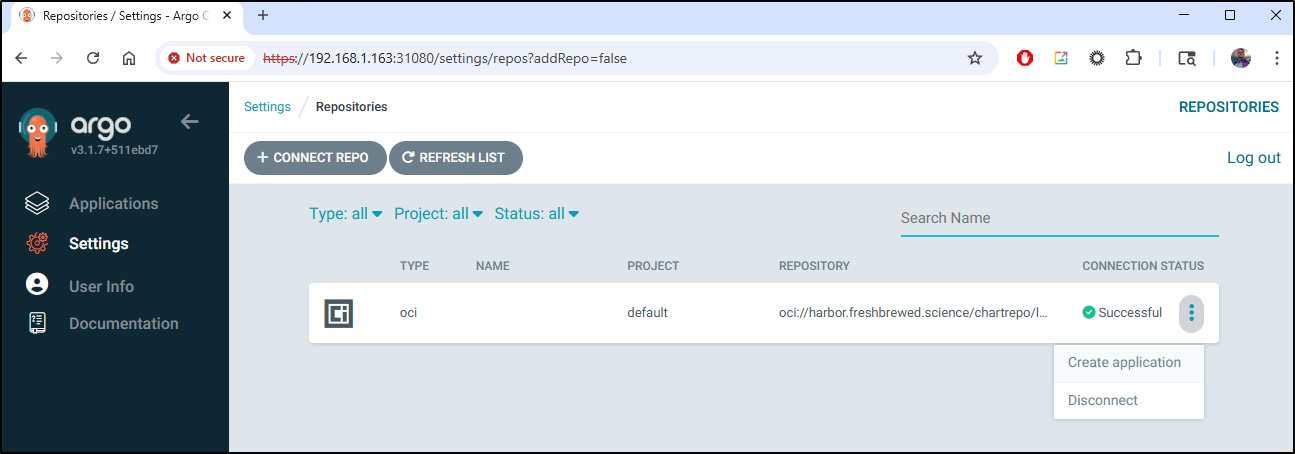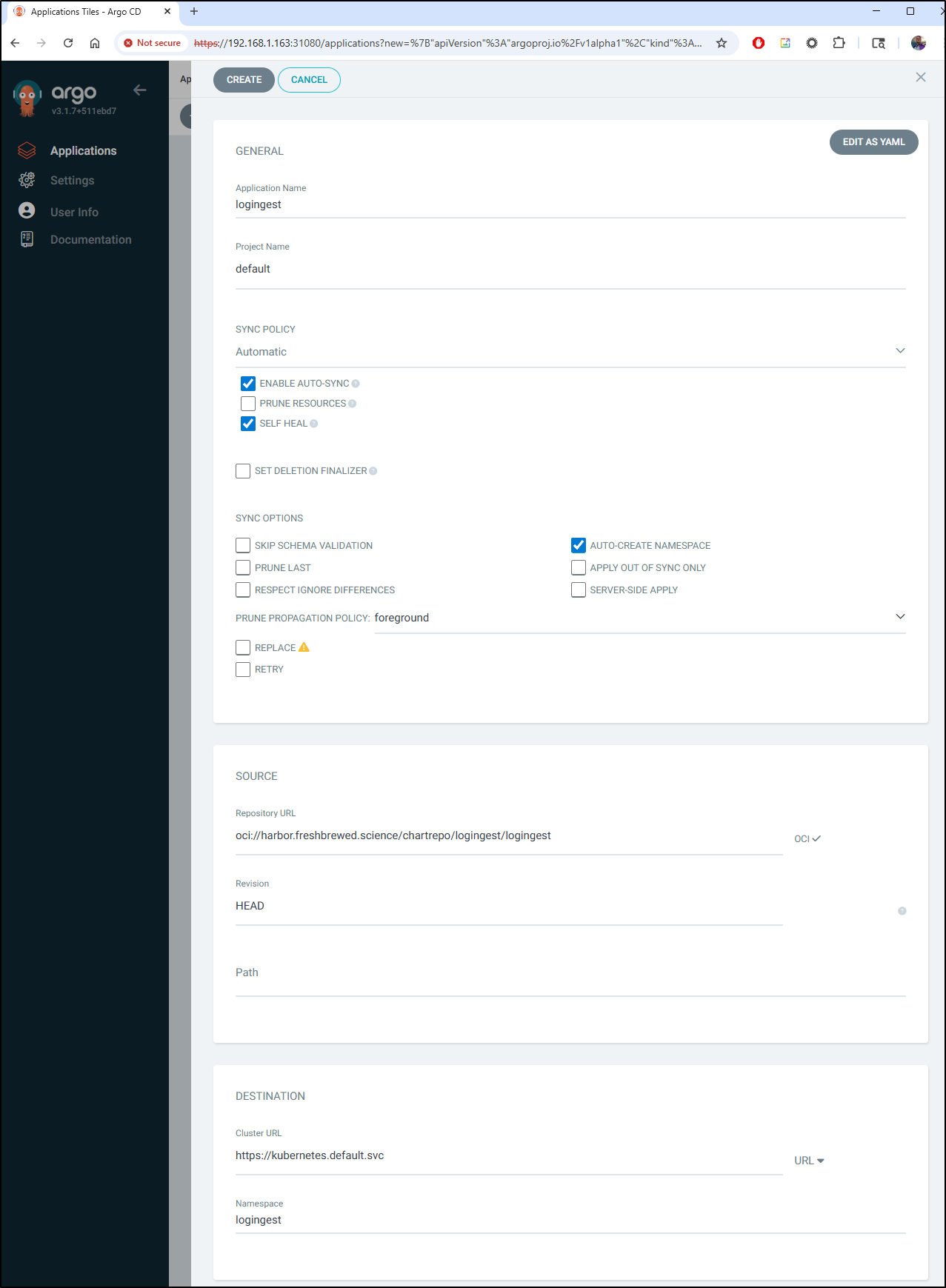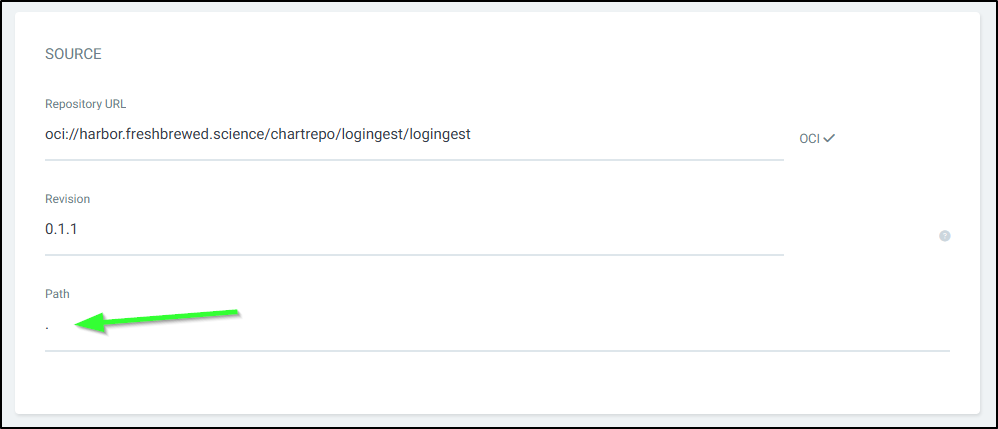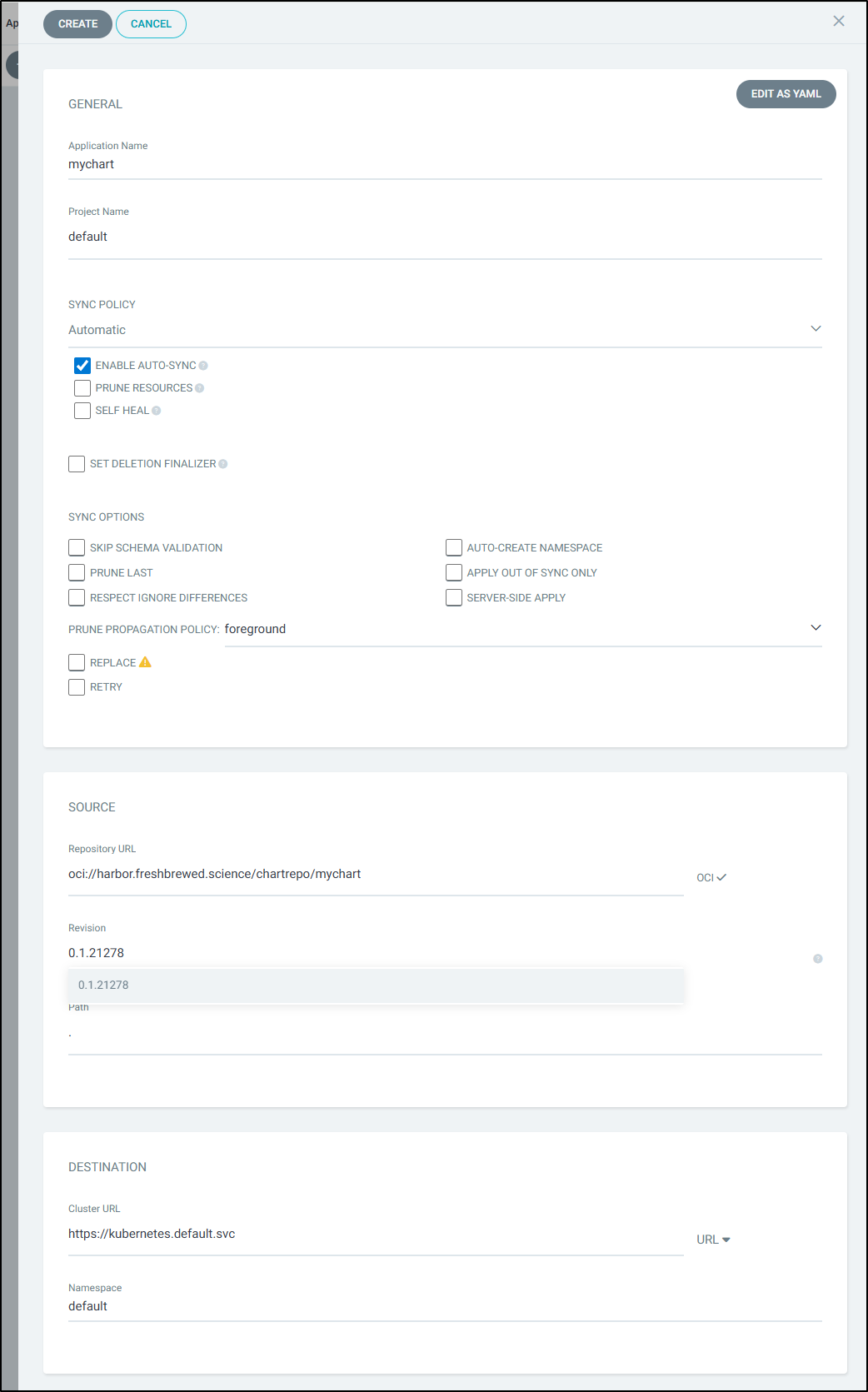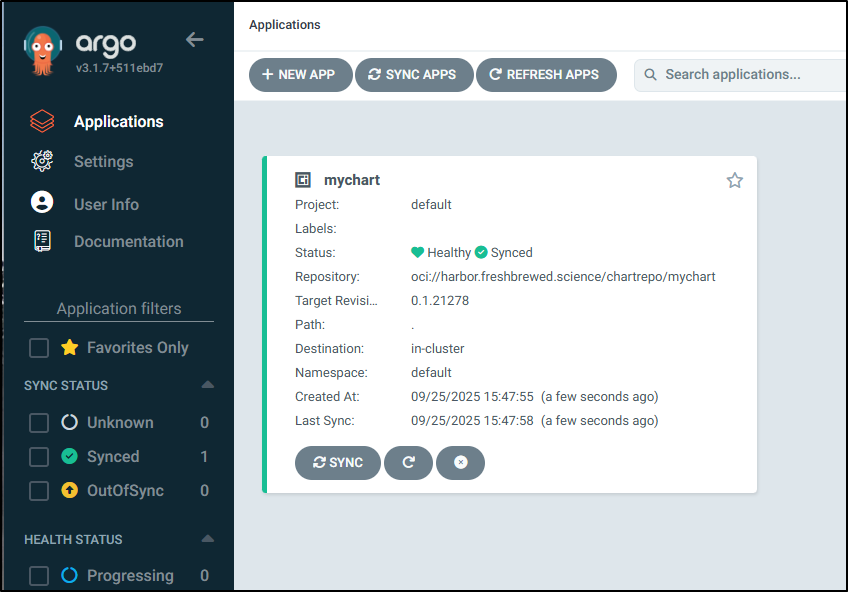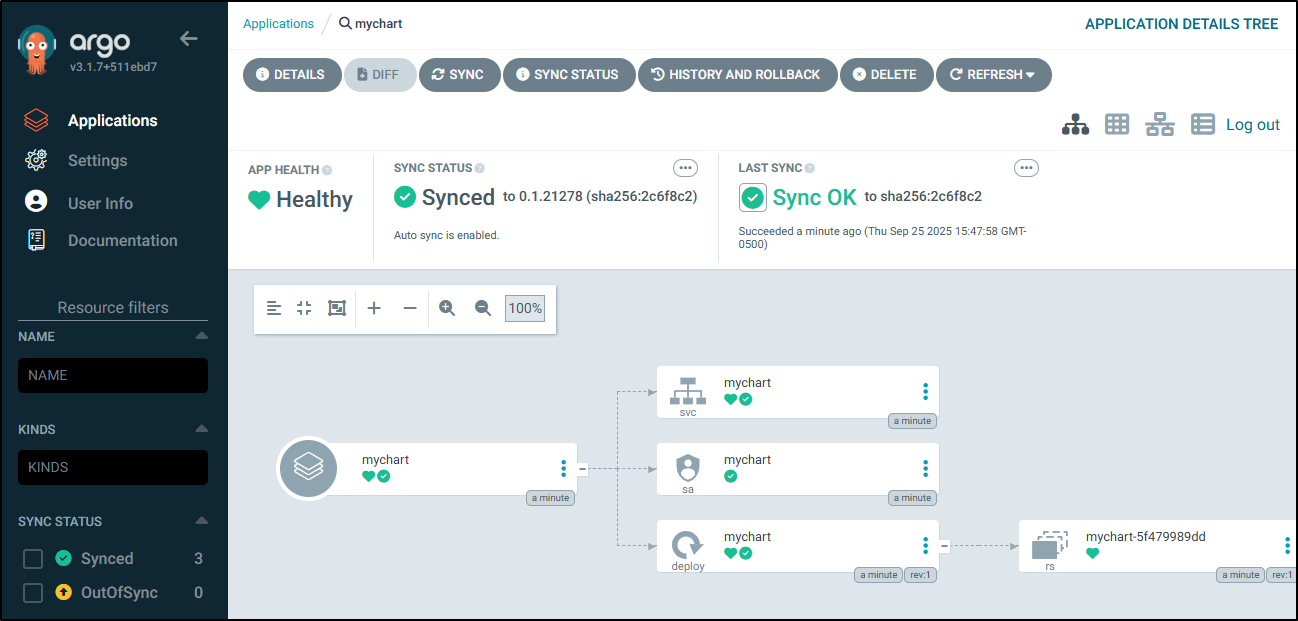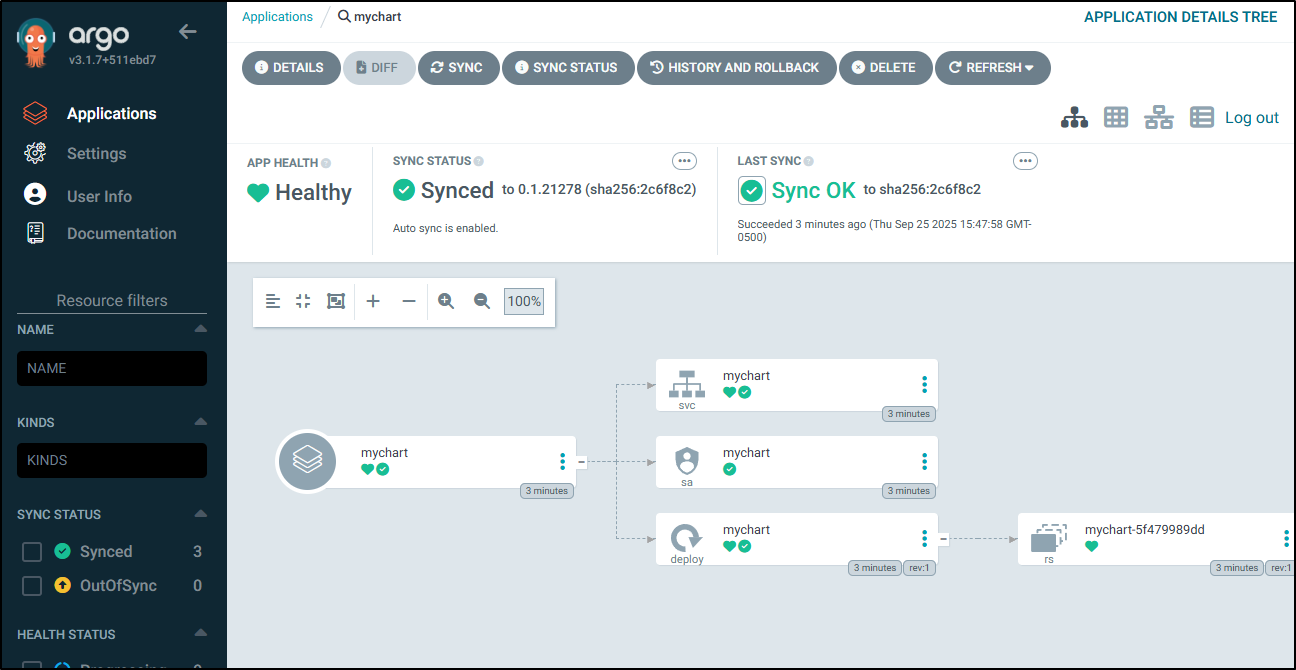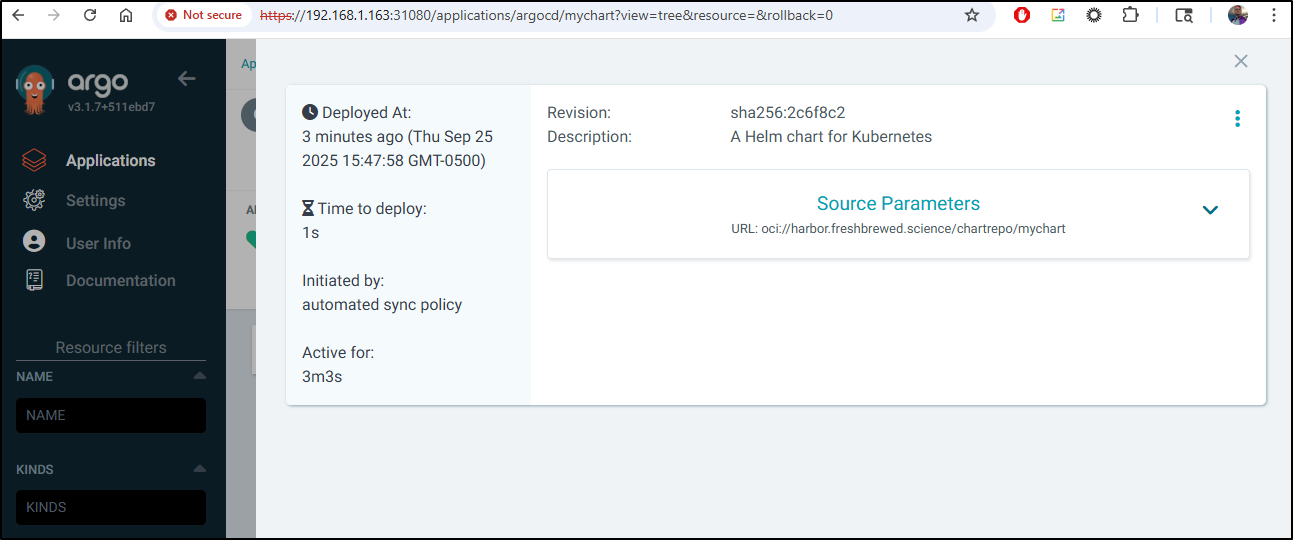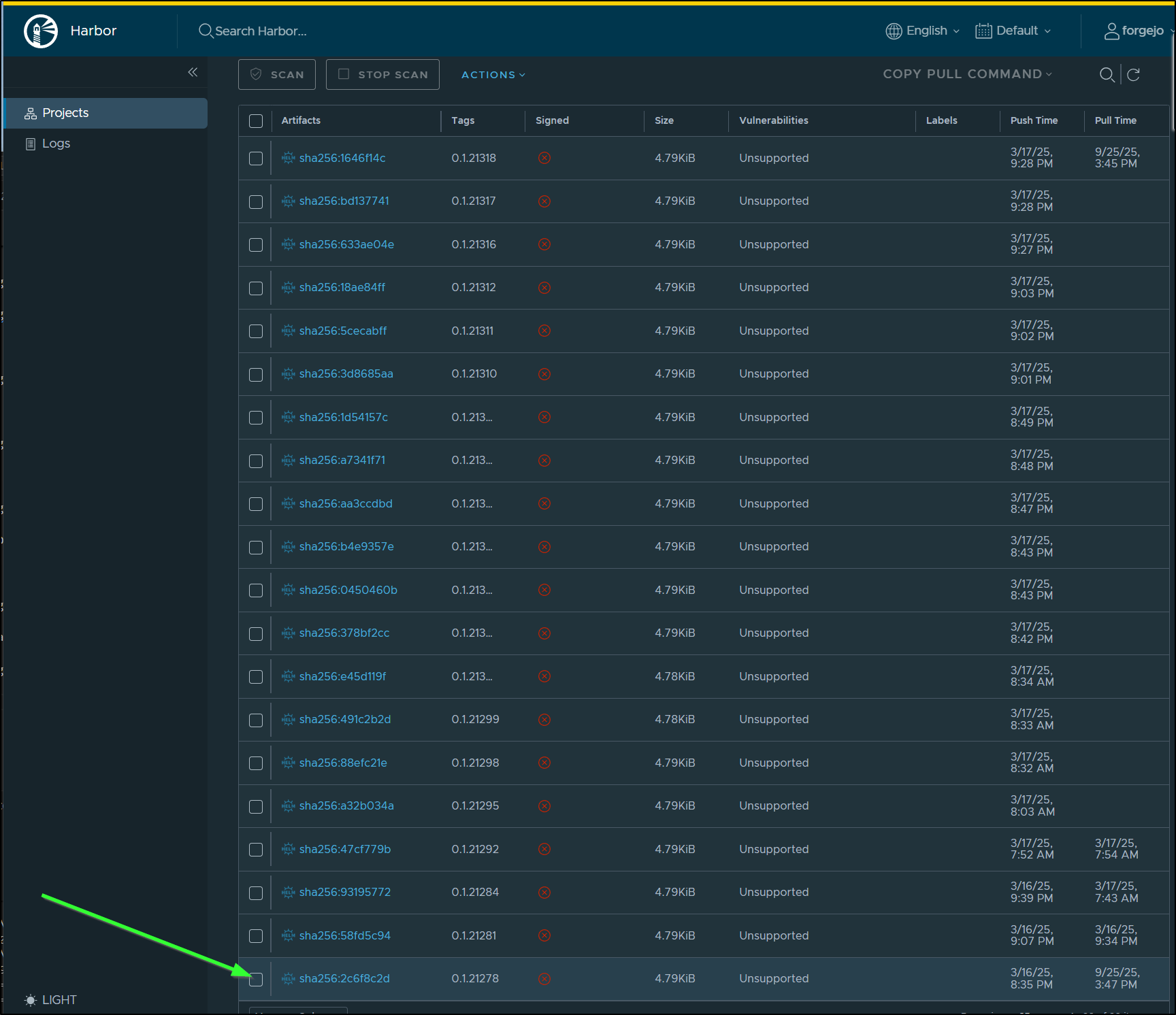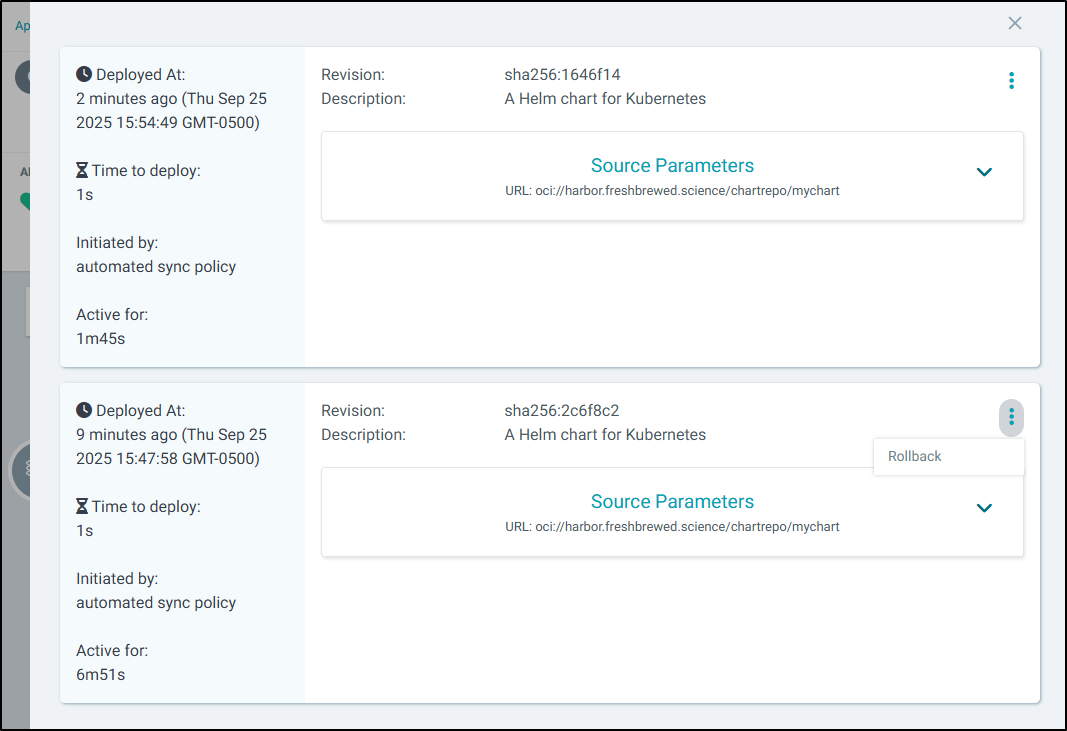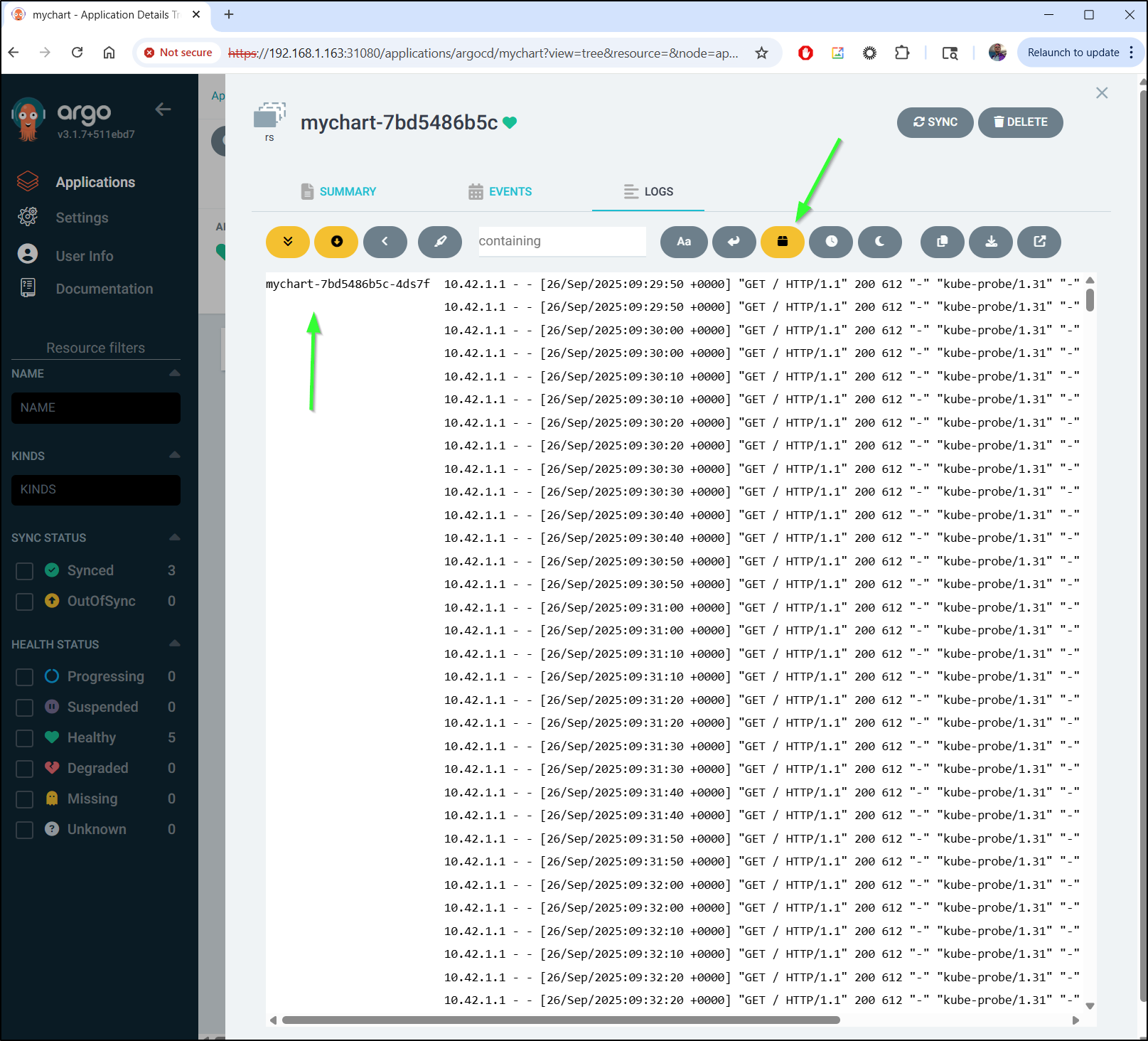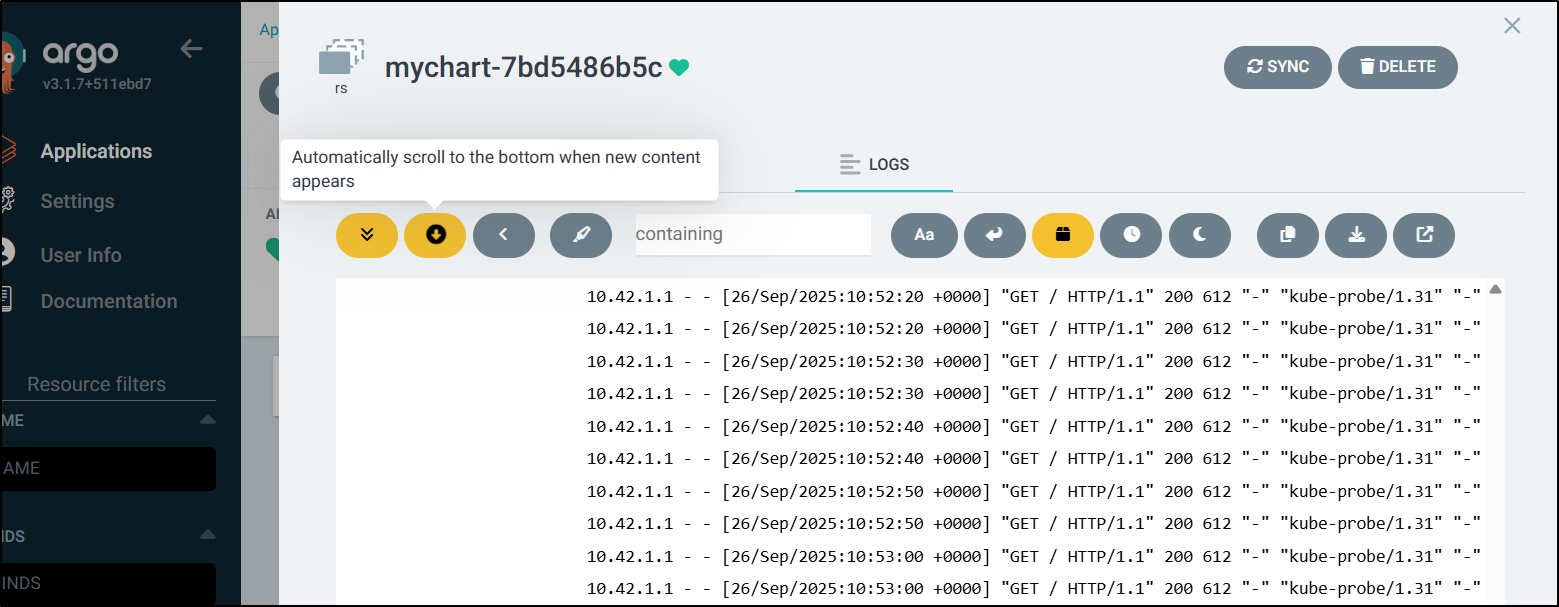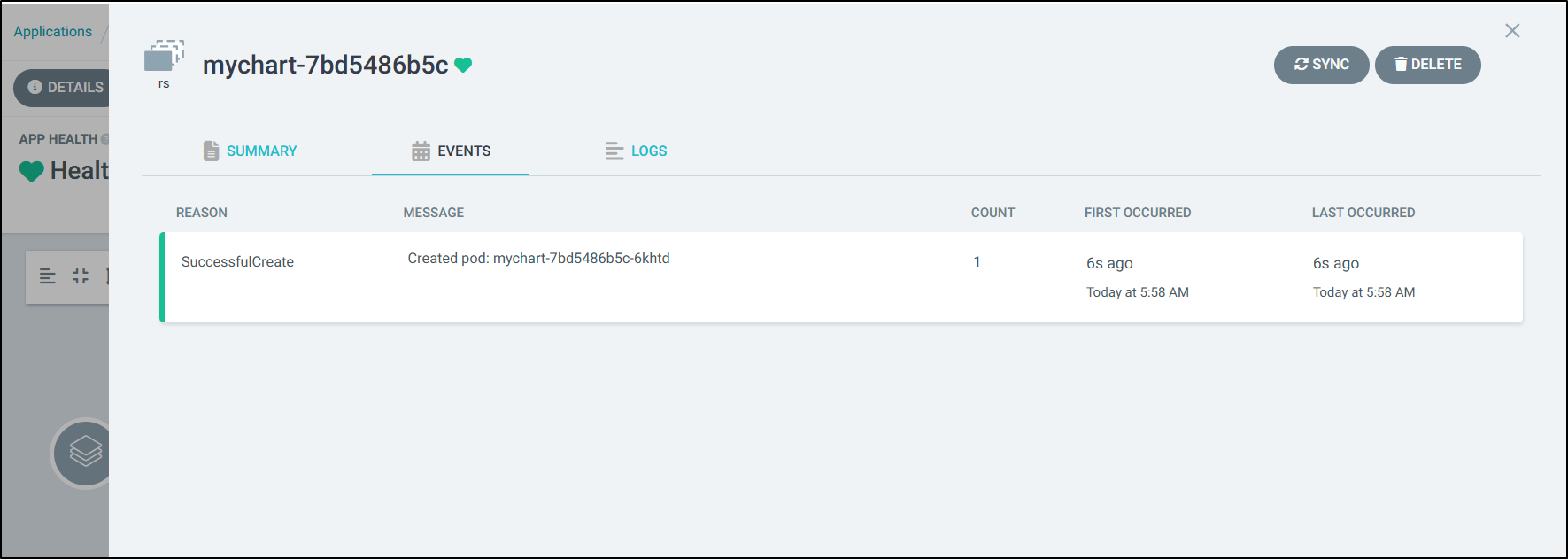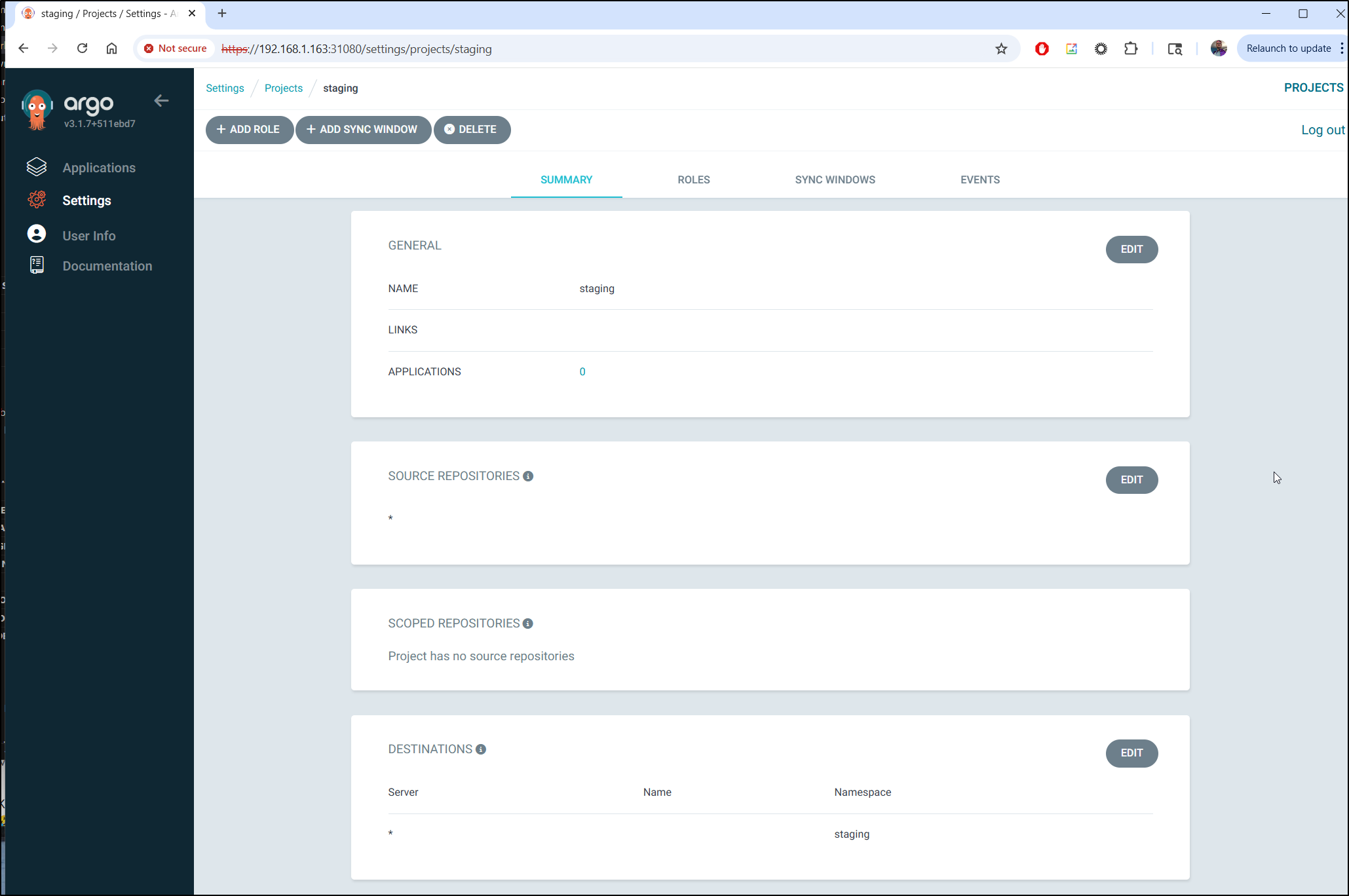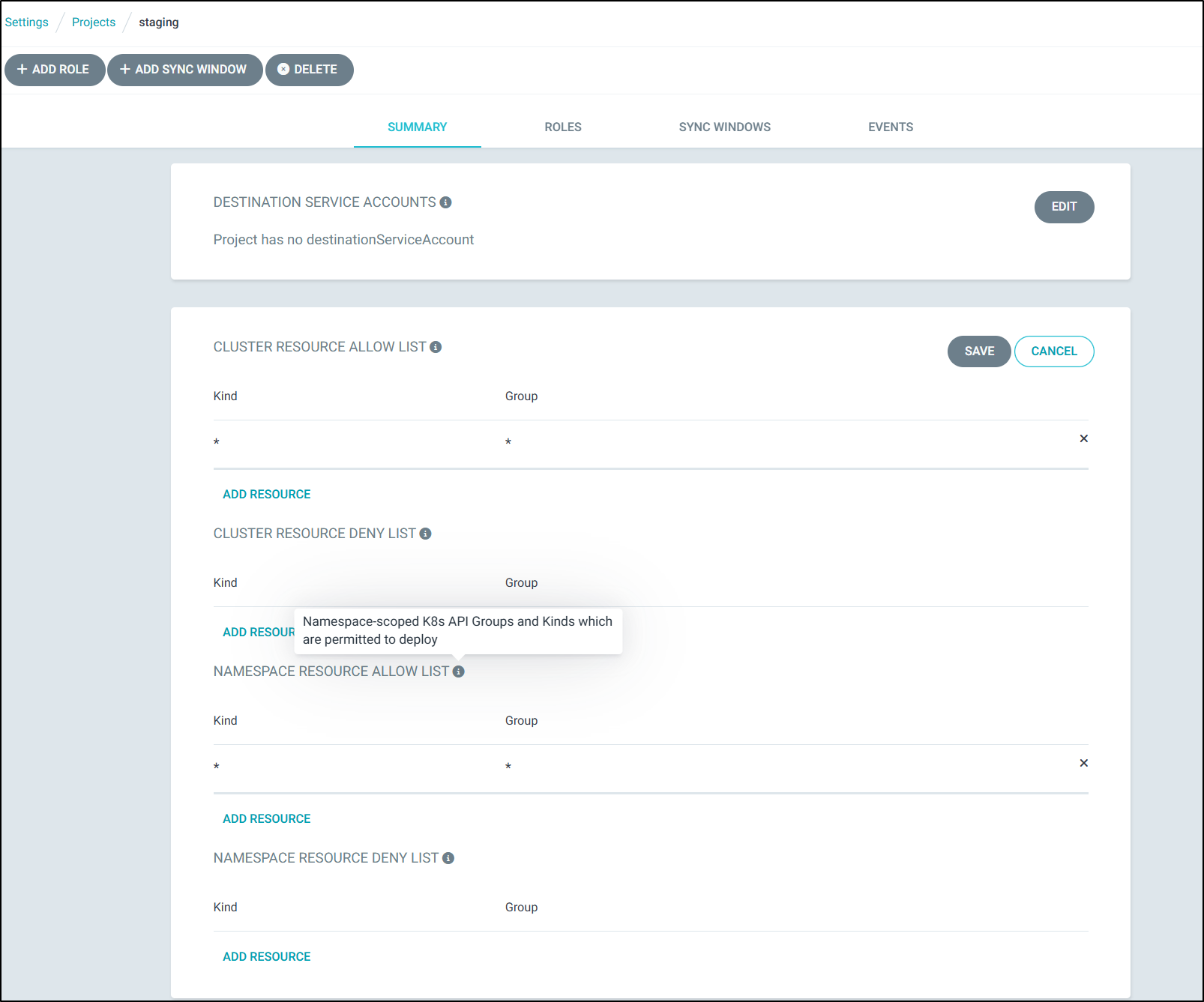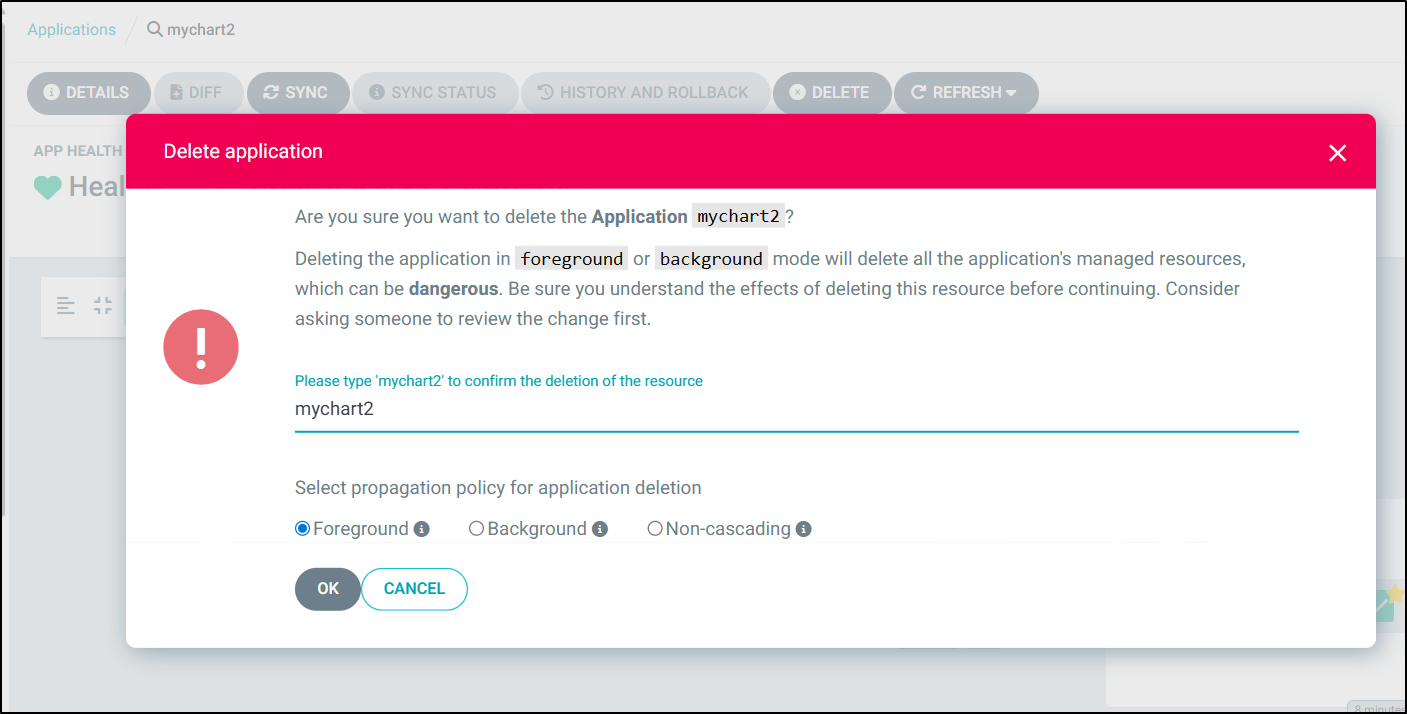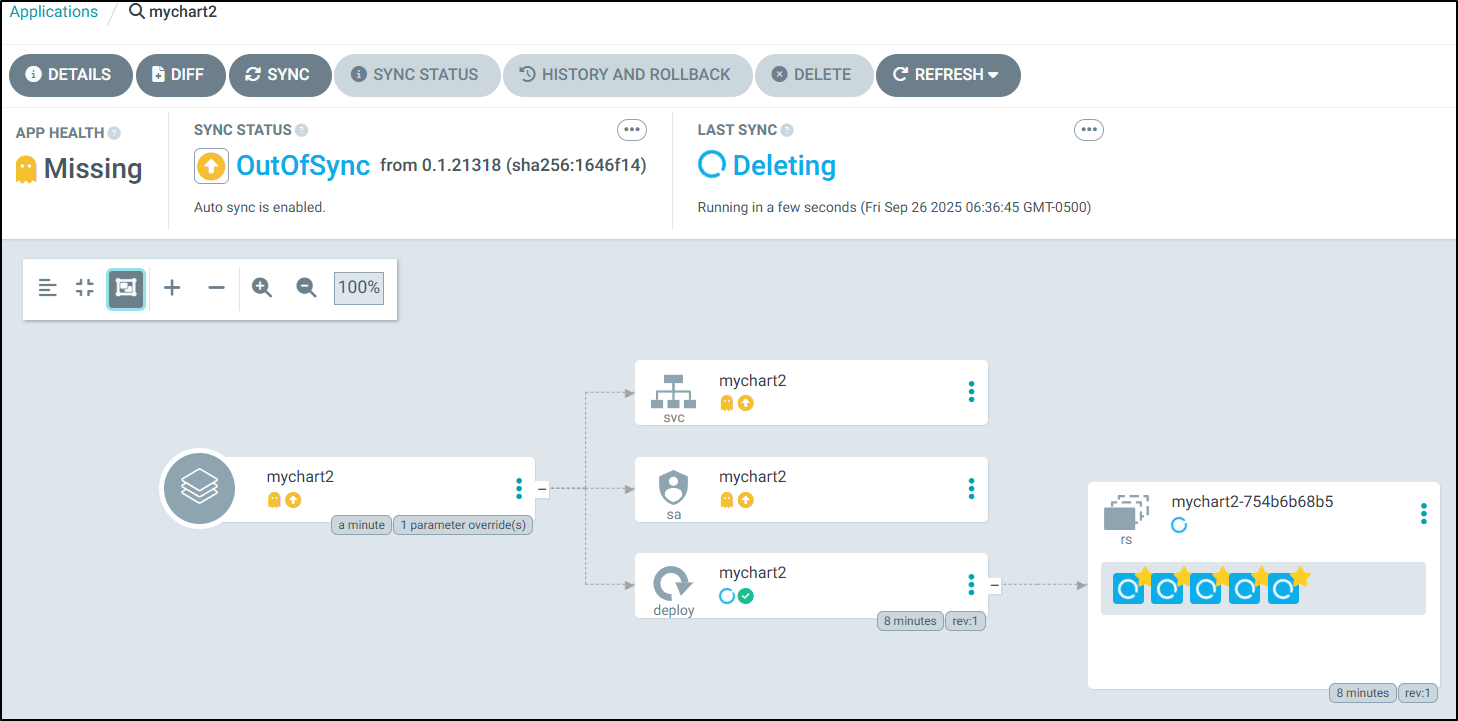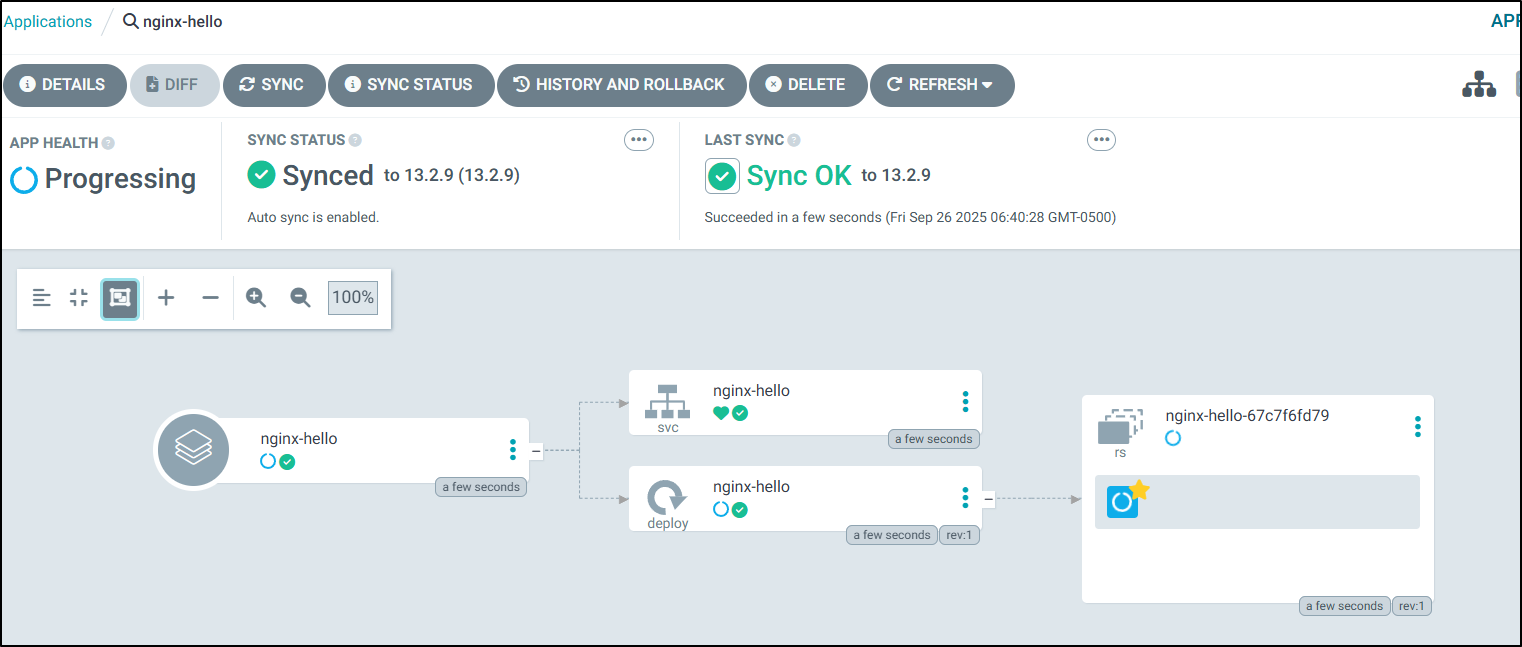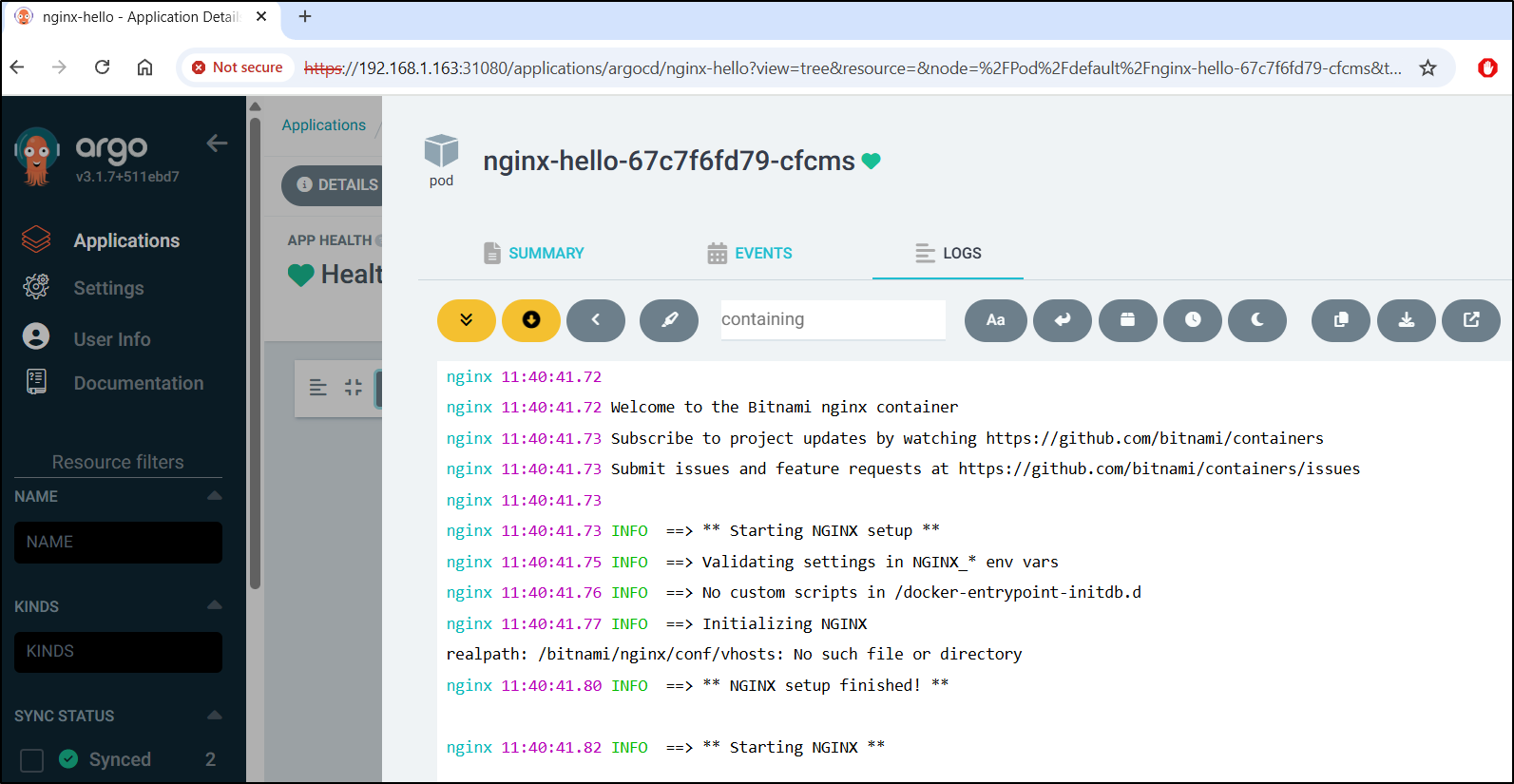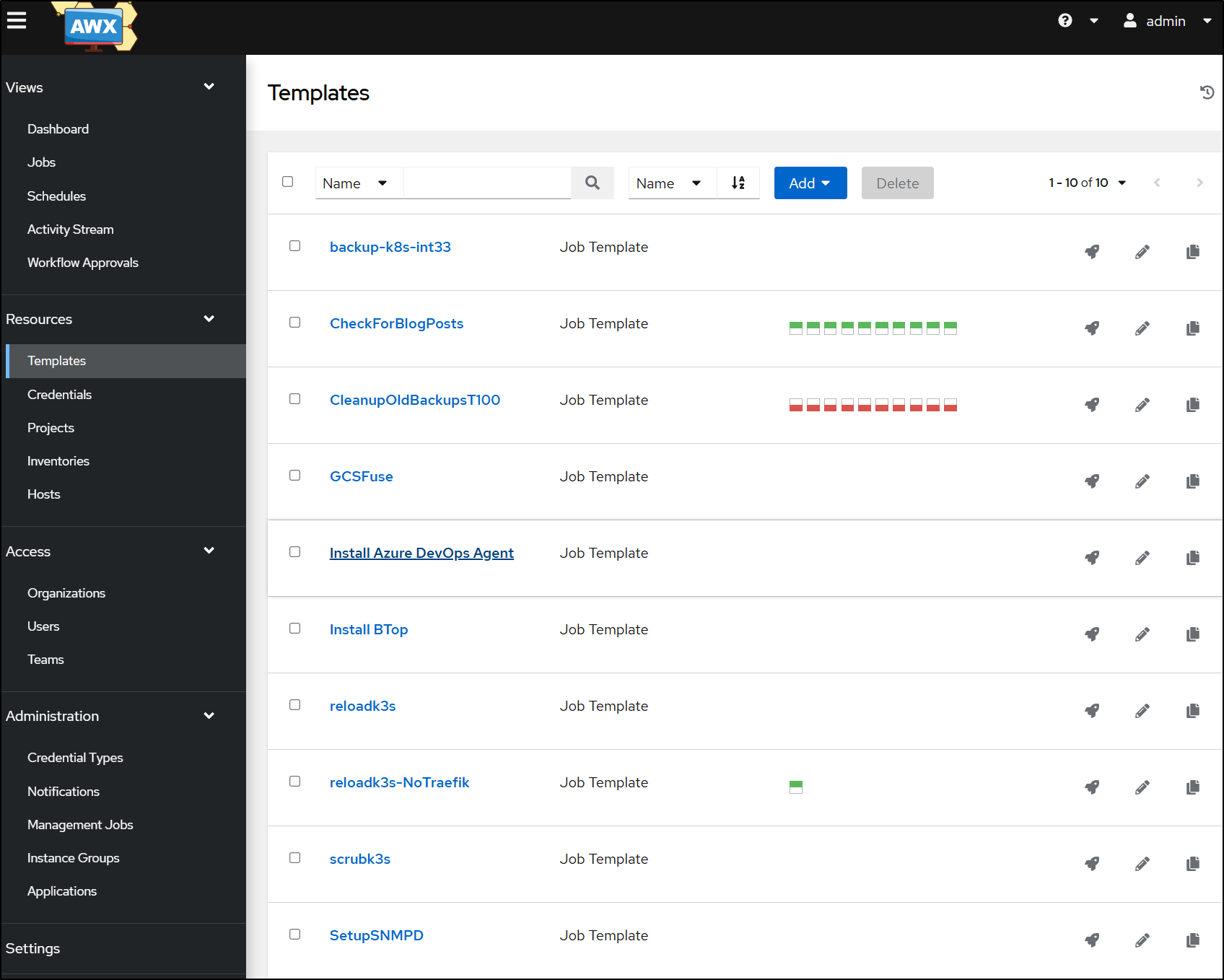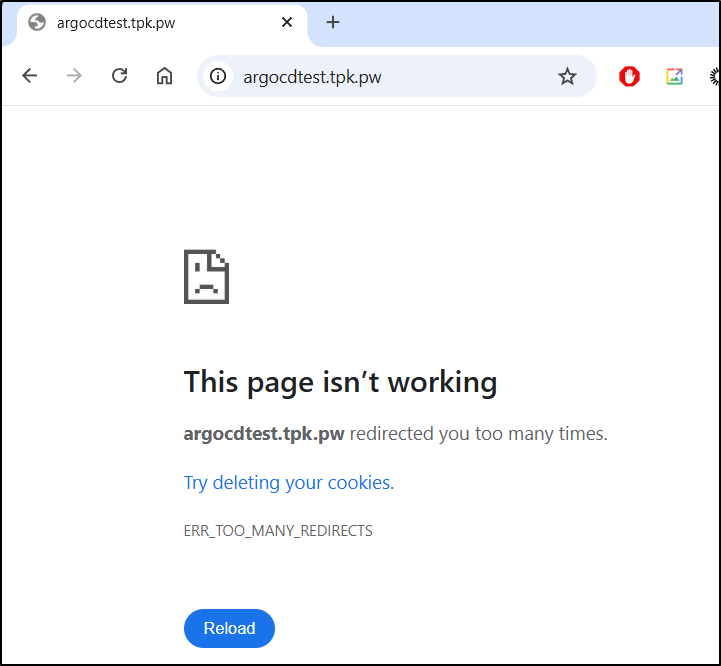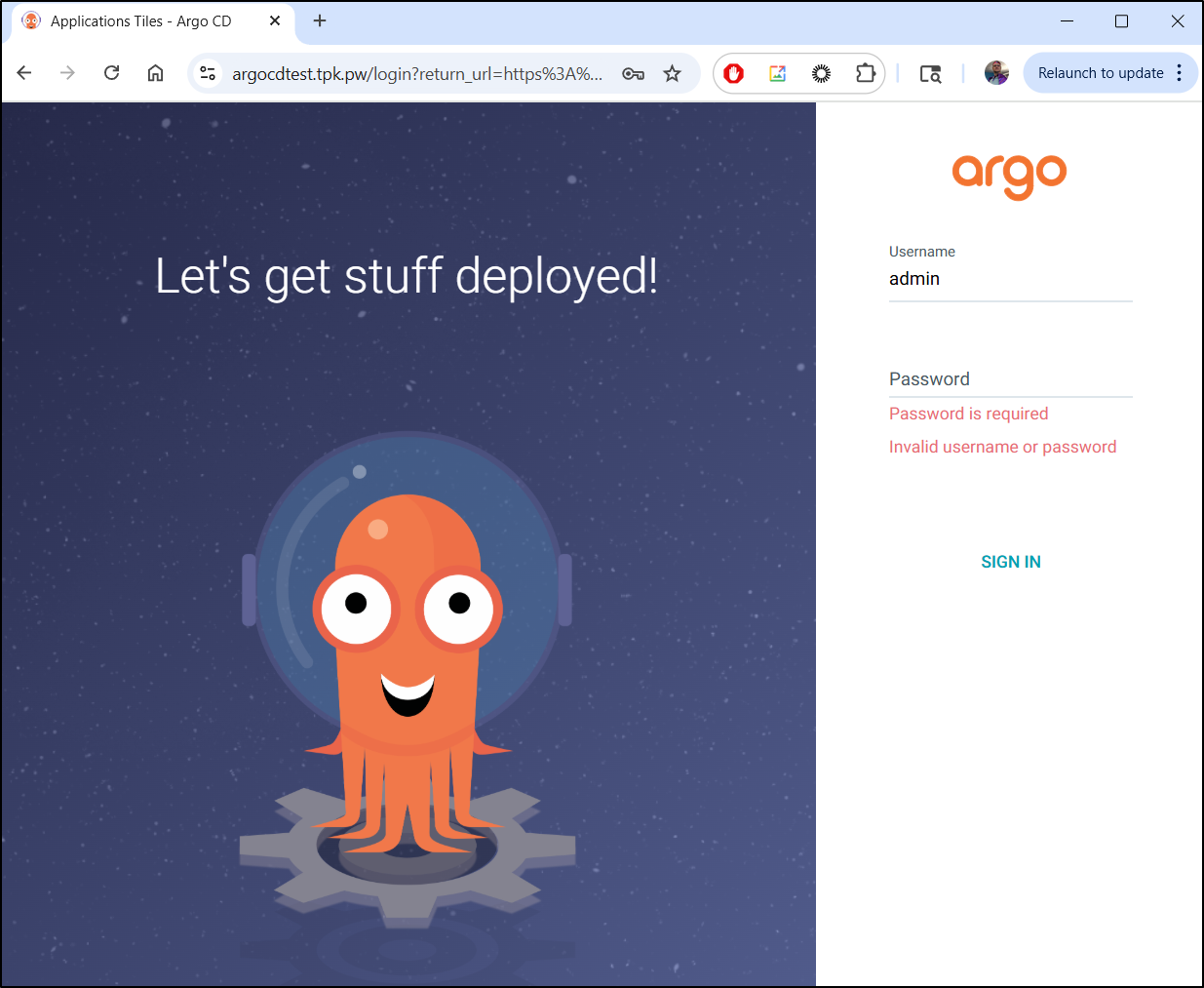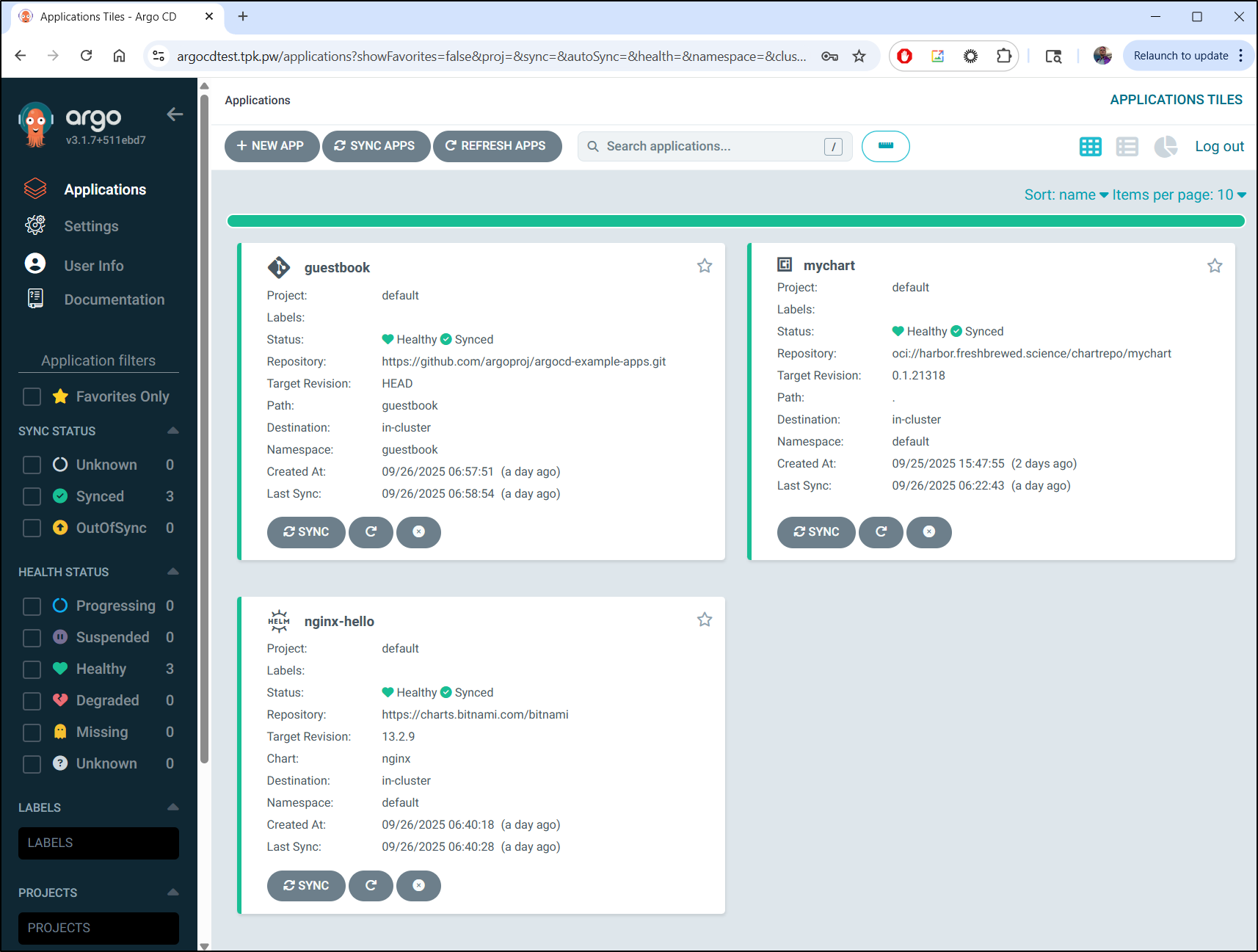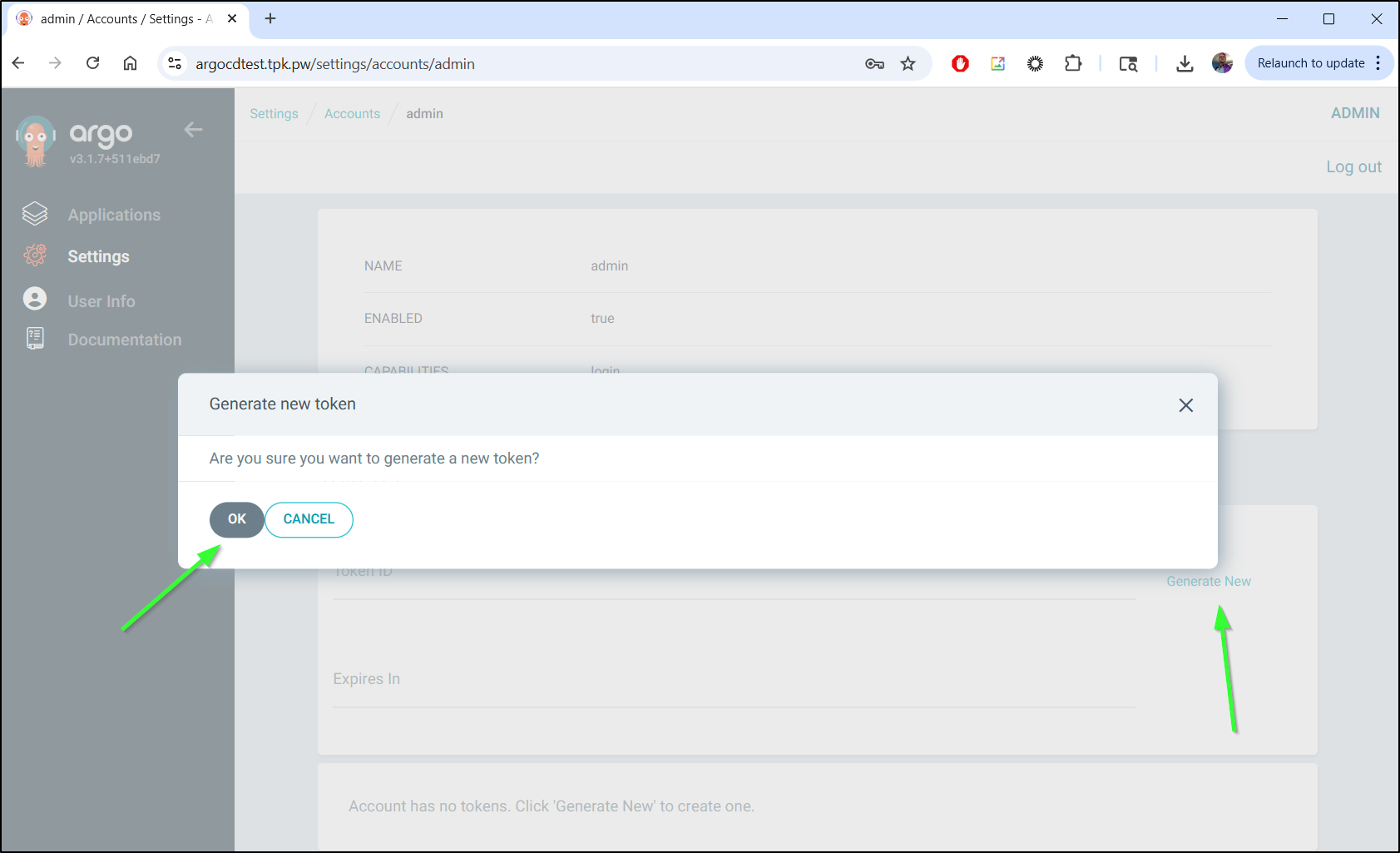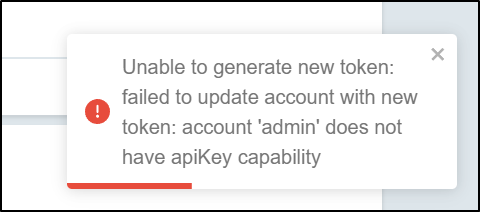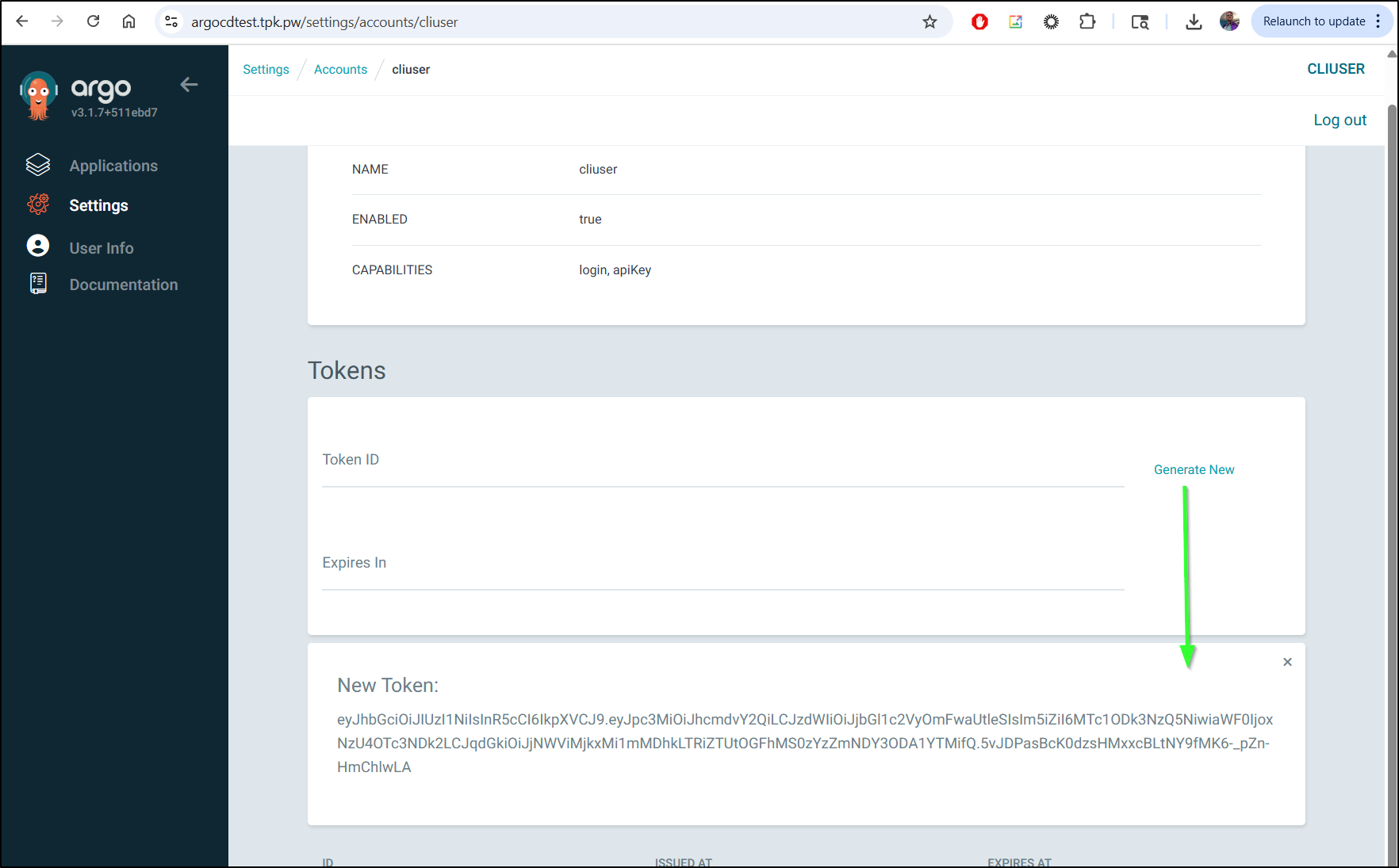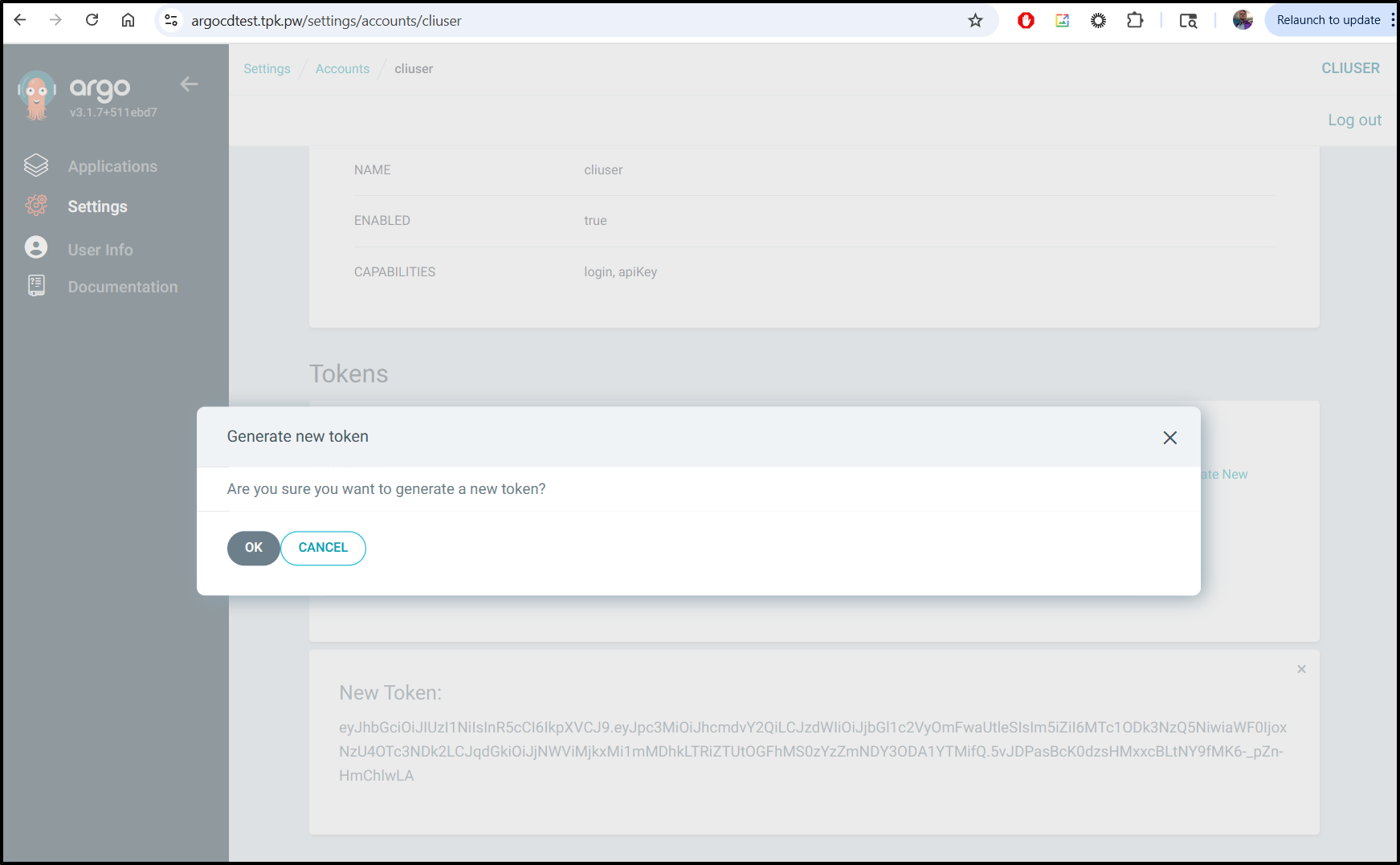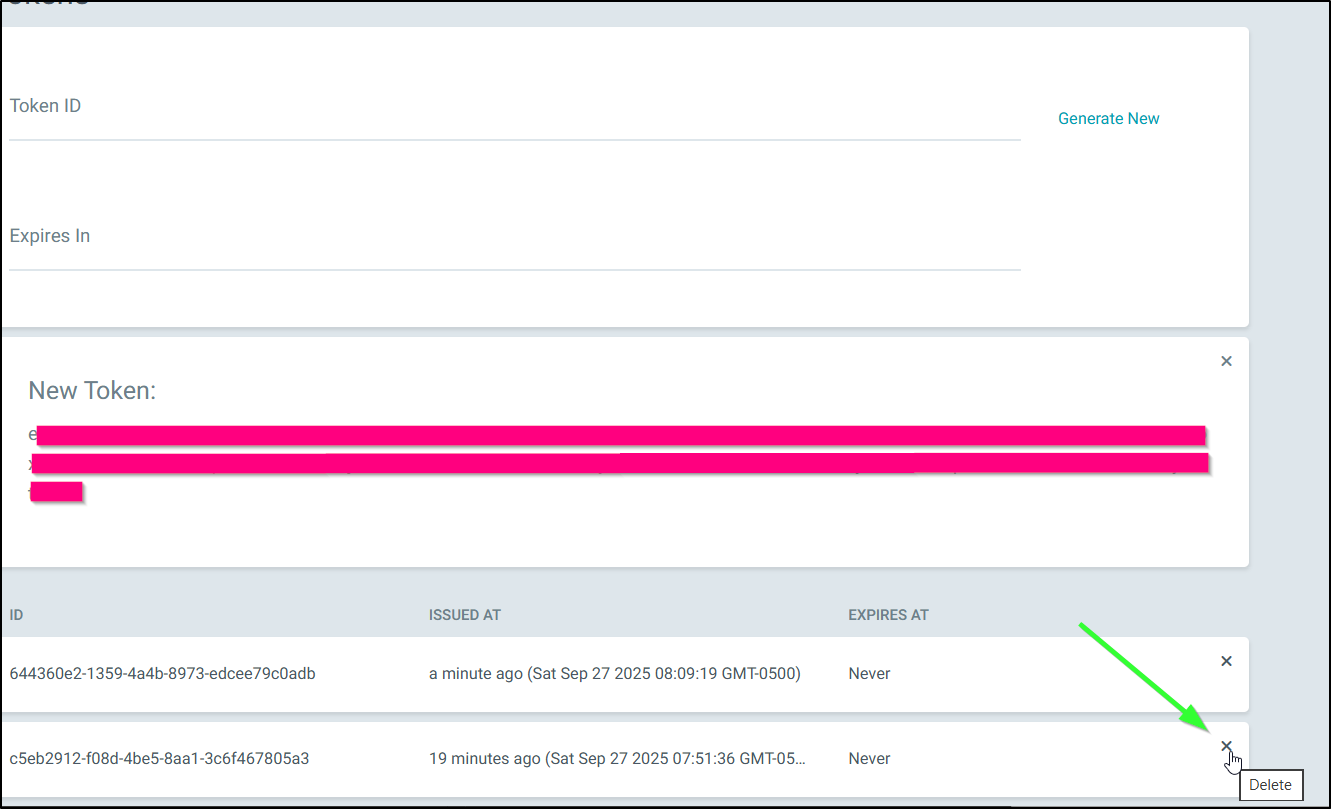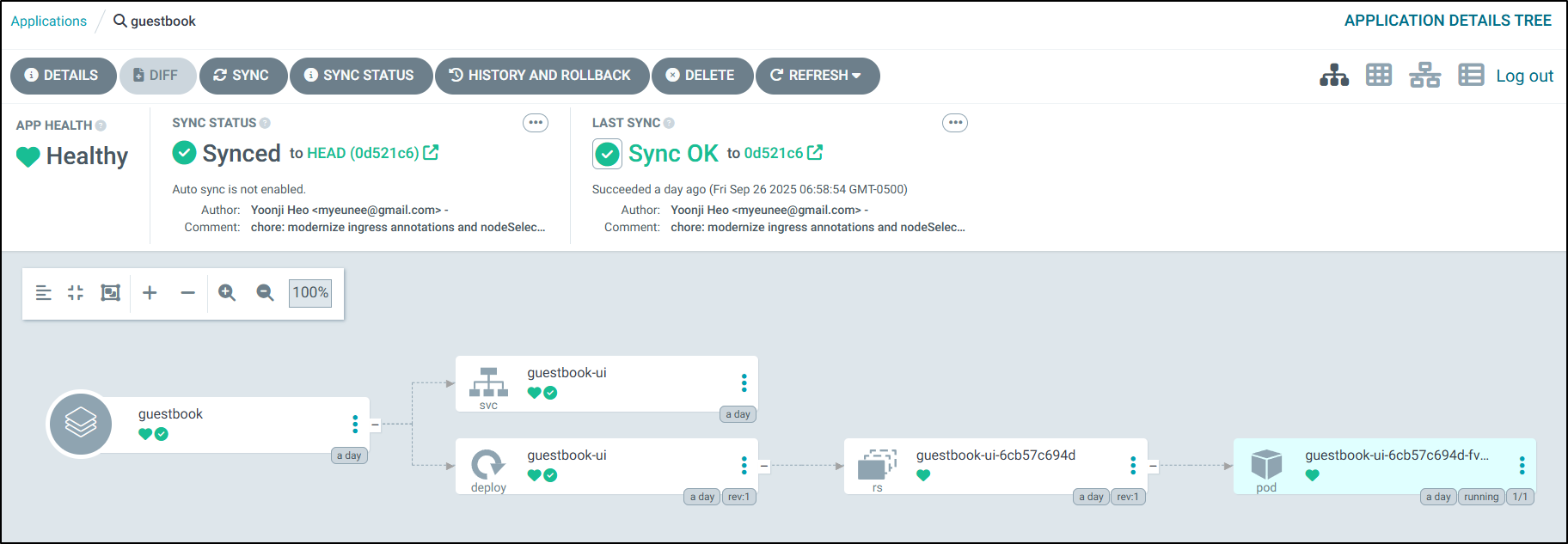Published: Oct 9, 2025 by Isaac Johnson
There are some that may think I have it out for tools like Jenkins and ArgoCD. Yes, I do have it out for Jenkins (while I don’t use Harness, I sure enjoyed their latest ad). But I have no such beef with ArgoCD.
In fact, three years ago I presented to OpenSource North on the topic “Three ways to GitOps” that focused on Flux and ArgoCD. I also wrote about it last back in 2022
The issue I always had with ArgoCD was it just worked on pre-baked manifests. Sometimes you could jerry rig helm, or use Kustomize, but it was really just designed to rectify YAML manifests and most teams I saw use it had pipelines that had to push updates to GIT just to get the CD to kick off.
ArgoCD 3.1
An InfoQ article in August thus caught my attention when it said not only has ArgoCD had some pretty major UI updates, it would now natively support OCI registries. This makes it much more interesting to me as by using OCI, we can bundle both our containers and their respective charts.
The article is well written with lots of big words. Very professional. I decided now is just a good time to bang on it and see what it does.
I think I’m just a simpleton that needs to try and put blocks in spaces
Installation
We should just need to create a namespace and apply the ArgoCD manifest
$ kubectl create namespace argocd
namespace/argocd created
$ kubectl apply -n argocd -f https://raw.githubusercontent.com/argoproj/argo-cd/stable/manifests/install.yaml
customresourcedefinition.apiextensions.k8s.io/applications.argoproj.io created
customresourcedefinition.apiextensions.k8s.io/applicationsets.argoproj.io created
customresourcedefinition.apiextensions.k8s.io/appprojects.argoproj.io created
serviceaccount/argocd-application-controller created
serviceaccount/argocd-applicationset-controller created
serviceaccount/argocd-dex-server created
serviceaccount/argocd-notifications-controller created
serviceaccount/argocd-redis created
serviceaccount/argocd-repo-server created
serviceaccount/argocd-server created
role.rbac.authorization.k8s.io/argocd-application-controller created
role.rbac.authorization.k8s.io/argocd-applicationset-controller created
role.rbac.authorization.k8s.io/argocd-dex-server created
role.rbac.authorization.k8s.io/argocd-notifications-controller created
role.rbac.authorization.k8s.io/argocd-redis created
role.rbac.authorization.k8s.io/argocd-server created
clusterrole.rbac.authorization.k8s.io/argocd-application-controller created
clusterrole.rbac.authorization.k8s.io/argocd-applicationset-controller created
clusterrole.rbac.authorization.k8s.io/argocd-server created
rolebinding.rbac.authorization.k8s.io/argocd-application-controller created
rolebinding.rbac.authorization.k8s.io/argocd-applicationset-controller created
rolebinding.rbac.authorization.k8s.io/argocd-dex-server created
rolebinding.rbac.authorization.k8s.io/argocd-notifications-controller created
rolebinding.rbac.authorization.k8s.io/argocd-redis created
rolebinding.rbac.authorization.k8s.io/argocd-server created
clusterrolebinding.rbac.authorization.k8s.io/argocd-application-controller created
clusterrolebinding.rbac.authorization.k8s.io/argocd-applicationset-controller created
clusterrolebinding.rbac.authorization.k8s.io/argocd-server created
configmap/argocd-cm created
configmap/argocd-cmd-params-cm created
configmap/argocd-gpg-keys-cm created
configmap/argocd-notifications-cm created
configmap/argocd-rbac-cm created
configmap/argocd-ssh-known-hosts-cm created
configmap/argocd-tls-certs-cm created
secret/argocd-notifications-secret created
secret/argocd-secret created
service/argocd-applicationset-controller created
service/argocd-dex-server created
service/argocd-metrics created
service/argocd-notifications-controller-metrics created
service/argocd-redis created
service/argocd-repo-server created
service/argocd-server createdhttps://argo-cd.readthedocs.io/en/stable/security_considerations/
service/argocd-server-metrics created
deployment.apps/argocd-applicationset-controller created
deployment.apps/argocd-dex-server created
deployment.apps/argocd-notifications-controller created
deployment.apps/argocd-redis created
deployment.apps/argocd-repo-server created
deployment.apps/argocd-server created
statefulset.apps/argocd-application-controller created
networkpolicy.networking.k8s.io/argocd-application-controller-network-policy created
networkpolicy.networking.k8s.io/argocd-applicationset-controller-network-policy created
networkpolicy.networking.k8s.io/argocd-dex-server-network-policy created
networkpolicy.networking.k8s.io/argocd-notifications-controller-network-policy created
networkpolicy.networking.k8s.io/argocd-redis-network-policy created
networkpolicy.networking.k8s.io/argocd-repo-server-network-policy created
networkpolicy.networking.k8s.io/argocd-server-network-policy created
By default, it creates a bunch of ClusterIP services and suggests you do the work for an LB or Ingress
$ kubectl get svc -n argocd
NAME TYPE CLUSTER-IP EXTERNAL-IP PORT(S) AGE
argocd-applicationset-controller ClusterIP 10.43.63.214 <none> 7000/TCP,8080/TCP 99s
argocd-dex-server ClusterIP 10.43.179.31 <none> 5556/TCP,5557/TCP,5558/TCP 99s
argocd-metrics ClusterIP 10.43.118.109 <none> 8082/TCP 99s
argocd-notifications-controller-metrics ClusterIP 10.43.46.252 <none> 9001/TCP 99s
argocd-redis ClusterIP 10.43.206.179 <none> 6379/TCP 99s
argocd-repo-server ClusterIP 10.43.195.240 <none> 8081/TCP,8084/TCP 99s
argocd-server ClusterIP 10.43.237.36 <none> 80/TCP,443/TCP 99s
argocd-server-metrics ClusterIP 10.43.31.206 <none> 8083/TCP 99s
I’m a fan, at least for testing, of using a nice NodePort service so I can hit any node to just view the app (instead of invoking a port-forward).
Let’s set that up now:
apiVersion: v1
kind: Service
metadata:
name: argocd-server-nodeport
namespace: argocd
labels:
app.kubernetes.io/component: server
app.kubernetes.io/name: argocd-server-nodeport
app.kubernetes.io/part-of: argocd
spec:
type: NodePort
internalTrafficPolicy: Cluster
ipFamilies:
- IPv4
ipFamilyPolicy: SingleStack
selector:
app.kubernetes.io/name: argocd-server
ports:
- name: http
port: 80
targetPort: 8080
protocol: TCP
nodePort: 31080
- name: https
port: 443
targetPort: 8080
protocol: TCP
nodePort: 31443
I’ll apply it
$ kubectl apply -f ./argo-nodeport.yaml -n argocd
service/argocd-server-nodeport created
And now I can see it listed
$ kubectl get svc -n argocd
NAME TYPE CLUSTER-IP EXTERNAL-IP PORT(S) AGE
argocd-applicationset-controller ClusterIP 10.43.63.214 <none> 7000/TCP,8080/TCP 6m44s
argocd-dex-server ClusterIP 10.43.179.31 <none> 5556/TCP,5557/TCP,5558/TCP 6m44s
argocd-metrics ClusterIP 10.43.118.109 <none> 8082/TCP 6m44s
argocd-notifications-controller-metrics ClusterIP 10.43.46.252 <none> 9001/TCP 6m44s
argocd-redis ClusterIP 10.43.206.179 <none> 6379/TCP 6m44s
argocd-repo-server ClusterIP 10.43.195.240 <none> 8081/TCP,8084/TCP 6m44s
argocd-server ClusterIP 10.43.237.36 <none> 80/TCP,443/TCP 6m44s
argocd-server-metrics ClusterIP 10.43.31.206 <none> 8083/TCP 6m44s
argocd-server-nodeport NodePort 10.43.152.6 <none> 80:31080/TCP,443:31443/TCP 16s
I can now hit the 80 (http) URL - I was surprised that even on 80 it serves a self-signed SSL connection (https)
We can get the initial admin user password from the Kubernetes secret:
$ kubectl get secrets -n argocd argocd-initial-admin-secret -o json | jq -r .data.password | base64 --decode
ASDFasdfASDFasdfASDF
and login
OCI Repos
Let’s try adding an OCI repo. In Settings / Repositories, let’s “+ Connect Repo”. Don’t let the logo for GIT throw you…
I’ll change from SSH to HTTP/HTTPS
Now we can see type “OCI” in the list
Let’s try and get my logingest chart to pull in
I will give it the OCI url oci://harbor.freshbrewed.science/chartrepo/logingest/logingest and pass a user and password
This would match what we might use with helm, e.g.
$ helm pull oci://harbor.freshbrewed.science/chartrepo/logingest/logingest --version 0.1.1
I can see it’s successful, from there I can use the menu to create an application
I filled in the details
but then saw some errors about the path. It took me a few to figure out what they wanted. The “path” is just so that when it pulls the chart from the URL, if the chart was in, say a subfolder, you could reference that. In most cases, if your OCI is the chart, you can use “.”
Unfortunately, that particular chart had a bug (misspelling) so I pivoted to know I know works, my pyk8service
I pivoted to a basic Nginx chart I have there
which worked dandy
I can see it synced without issue
That said, like the others I tried, it does not like “HEAD” - so I needed to set my version each time.
I can view the objects it deployed
And I can always look at history to see when it deployed and of what revision
You can see above that it synced “to 0.1.21278 (sha256:2c6f8c2)”
Which matches the SHA in Harbor, but it’s not the latest
Switching it to the latest is pretty easy:
Had something gone wrong, I could always rollback in the UI
The version is also saved as an annotation in the deployment which is nice in case we are just looking at our cluster directly or via an APM
$ kubectl get deployments mychart -o yaml | head -n 42 | tail -n 6
labels:
app.kubernetes.io/instance: mychart
app.kubernetes.io/managed-by: Helm
app.kubernetes.io/name: mychart
app.kubernetes.io/version: 1.16.0
helm.sh/chart: mychart-0.1.21318
However, unlike a traditional Helm chart, we will not see it with Helm directly
Logs
Something I only now discovered - ArgoCD can include the Pod names in the logs. This is quite useful when trying to correlate with other systems or see when a given pod crashed.
We can also use this page as a live tail, showing the latest logs as they appear.
This can be helpful in troubleshooting issues where you want to see which containers are picking up traffic, or catching debug output in a more controlled environment like staging or production.
Events
We can use events to track things like a Replicaset restoring a terminated pod
Scaling
We can use the UI to easily scale out and in if we see a demand on service:
Projects and Kubernetes
We showed using the UI. Let’s move on to the objects we can create and modify within Kubernetes.
For instance, we can view our ArgoCD projects from the apiVersion argoproj.io/v1alpha1 and kind AppProject
$ kubectl get AppProject -A
NAMESPACE NAME AGE
argocd default 16h
The output of the YAML shows the namespaces and servers this project can use:
$ kubectl get AppProject default -n argocd -o yaml
apiVersion: argoproj.io/v1alpha1
kind: AppProject
metadata:
creationTimestamp: "2025-09-25T18:31:00Z"
generation: 1
name: default
namespace: argocd
resourceVersion: "5275222"
uid: 419f7071-d57d-40f8-a3ca-4063d62bec4a
spec:
clusterResourceWhitelist:
- group: '*'
kind: '*'
destinations:
- namespace: '*'
server: '*'
sourceRepos:
- '*'
status: {}
Let’s say we want a “Staging” project that would let us create and manage applications but they must always be in a “staging” namespace. I do not care about clusters and they come and go. I just want to limit our use of namespaces.
$ cat staging.prj.yaml
apiVersion: argoproj.io/v1alpha1
kind: AppProject
metadata:
name: staging
namespace: argocd
spec:
clusterResourceWhitelist:
- group: '*'
kind: '*'
destinations:
- namespace: 'staging'
server: '*'
sourceRepos:
- '*'
Once I apply it:
$ kubectl apply -f ./staging.prj.yaml
appproject.argoproj.io/staging created
I can see it light up with the destination namespace of “staging”
We can get pretty narrowly focused with projects even limiting the API Groups and Kinds
Only once can I recall seeing a place where I would use this - it was a product that would let developers launch devutil pods for debugging and only pods.
Personally, I’m more a fan of locking down namespaces and if it’s really important, use something like an Istio NetworkPolicy which comes with Istio (or in GKE, they call it Anthos Service Mesh). You can read more about NetworkPolicy usage here
Applications and Kubernetes
If you are thinking, “Can’t I also use YAML manifests for Applications”, then the answer is “Of course!”.
We can look at the application we did by hand:
$ kubectl get application -n argocd
NAME SYNC STATUS HEALTH STATUS
mychart Synced Healthy
The full manifest includes a lot of events, for example:
$ kubectl get application -n argocd -o yaml
apiVersion: v1
items:
- apiVersion: argoproj.io/v1alpha1
kind: Application
metadata:
creationTimestamp: "2025-09-25T20:47:55Z"
generation: 343
name: mychart
namespace: argocd
resourceVersion: "5316803"
uid: 71d0b1e5-d814-4015-8fd0-5ed404cb91ab
spec:
destination:
namespace: default
server: https://kubernetes.default.svc
project: default
source:
helm:
parameters:
- name: autoscaling.minReplicas
value: "2"
- name: replicaCount
value: "2"
path: .
repoURL: oci://harbor.freshbrewed.science/chartrepo/mychart
targetRevision: 0.1.21318
syncPolicy:
automated:
enabled: true
status:
controllerNamespace: argocd
health:
lastTransitionTime: "2025-09-26T11:03:39Z"
status: Healthy
history:
- deployStartedAt: "2025-09-25T20:47:57Z"
deployedAt: "2025-09-25T20:47:58Z"
id: 0
initiatedBy:
automated: true
revision: sha256:2c6f8c2d4eedda549717b9dc6986b1a28e4c86e087c689baba9b5103a4f1f390
source:
path: .
repoURL: oci://harbor.freshbrewed.science/chartrepo/mychart
targetRevision: 0.1.21278
- deployStartedAt: "2025-09-25T20:54:48Z"
deployedAt: "2025-09-25T20:54:49Z"
id: 1
initiatedBy:
automated: true
revision: sha256:1646f14c159bd8b7a1089d3a1c2687bc130aa50c0390a256c6ec0edfde1a8770
source:
path: .
repoURL: oci://harbor.freshbrewed.science/chartrepo/mychart
targetRevision: 0.1.21318
- deployStartedAt: "2025-09-26T11:00:01Z"
deployedAt: "2025-09-26T11:00:02Z"
id: 2
initiatedBy:
username: admin
revision: sha256:1646f14c159bd8b7a1089d3a1c2687bc130aa50c0390a256c6ec0edfde1a8770
source:
helm:
parameters:
- name: autoscaling.minReplicas
value: "10"
path: .
repoURL: oci://harbor.freshbrewed.science/chartrepo/mychart
targetRevision: 0.1.21318
- deployStartedAt: "2025-09-26T11:00:55Z"
deployedAt: "2025-09-26T11:00:56Z"
id: 3
initiatedBy:
username: admin
revision: sha256:1646f14c159bd8b7a1089d3a1c2687bc130aa50c0390a256c6ec0edfde1a8770
source:
helm:
parameters:
- name: autoscaling.minReplicas
value: "10"
path: .
repoURL: oci://harbor.freshbrewed.science/chartrepo/mychart
targetRevision: 0.1.21318
- deployStartedAt: "2025-09-26T11:01:43Z"
deployedAt: "2025-09-26T11:01:44Z"
id: 4
initiatedBy:
automated: true
revision: sha256:1646f14c159bd8b7a1089d3a1c2687bc130aa50c0390a256c6ec0edfde1a8770
source:
helm:
parameters:
- name: autoscaling.minReplicas
value: "10"
- name: replicaCount
value: "10"
path: .
repoURL: oci://harbor.freshbrewed.science/chartrepo/mychart
targetRevision: 0.1.21318
- deployStartedAt: "2025-09-26T11:03:08Z"
deployedAt: "2025-09-26T11:03:09Z"
id: 5
initiatedBy:
automated: true
revision: sha256:1646f14c159bd8b7a1089d3a1c2687bc130aa50c0390a256c6ec0edfde1a8770
source:
helm:
parameters:
- name: autoscaling.minReplicas
value: "10"
- name: replicaCount
value: "30"
path: .
repoURL: oci://harbor.freshbrewed.science/chartrepo/mychart
targetRevision: 0.1.21318
- deployStartedAt: "2025-09-26T11:03:47Z"
deployedAt: "2025-09-26T11:03:48Z"
id: 6
initiatedBy:
automated: true
revision: sha256:1646f14c159bd8b7a1089d3a1c2687bc130aa50c0390a256c6ec0edfde1a8770
source:
helm:
parameters:
- name: autoscaling.minReplicas
value: "2"
- name: replicaCount
value: "2"
path: .
repoURL: oci://harbor.freshbrewed.science/chartrepo/mychart
targetRevision: 0.1.21318
operationState:
finishedAt: "2025-09-26T11:03:48Z"
message: successfully synced (all tasks run)
operation:
initiatedBy:
automated: true
retry:
limit: 5
sync:
revision: sha256:1646f14c159bd8b7a1089d3a1c2687bc130aa50c0390a256c6ec0edfde1a8770
phase: Succeeded
startedAt: "2025-09-26T11:03:47Z"
syncResult:
resources:
- group: ""
hookPhase: Running
kind: ServiceAccount
message: serviceaccount/mychart unchanged
name: mychart
namespace: default
status: Synced
syncPhase: Sync
version: v1
- group: ""
hookPhase: Running
kind: Service
message: service/mychart unchanged
name: mychart
namespace: default
status: Synced
syncPhase: Sync
version: v1
- group: apps
hookPhase: Running
images:
- nginx:1.16.0
kind: Deployment
message: deployment.apps/mychart configured
name: mychart
namespace: default
status: Synced
syncPhase: Sync
version: v1
revision: sha256:1646f14c159bd8b7a1089d3a1c2687bc130aa50c0390a256c6ec0edfde1a8770
source:
helm:
parameters:
- name: autoscaling.minReplicas
value: "2"
- name: replicaCount
value: "2"
path: .
repoURL: oci://harbor.freshbrewed.science/chartrepo/mychart
targetRevision: 0.1.21318
reconciledAt: "2025-09-26T11:15:36Z"
resourceHealthSource: appTree
resources:
- kind: Service
name: mychart
namespace: default
status: Synced
version: v1
- kind: ServiceAccount
name: mychart
namespace: default
status: Synced
version: v1
- group: apps
kind: Deployment
name: mychart
namespace: default
status: Synced
version: v1
sourceHydrator: {}
sourceType: Helm
summary:
images:
- nginx:1.16.0
sync:
comparedTo:
destination:
namespace: default
server: https://kubernetes.default.svc
source:
helm:
parameters:
- name: autoscaling.minReplicas
value: "2"
- name: replicaCount
value: "2"
path: .
repoURL: oci://harbor.freshbrewed.science/chartrepo/mychart
targetRevision: 0.1.21318
revision: sha256:1646f14c159bd8b7a1089d3a1c2687bc130aa50c0390a256c6ec0edfde1a8770
status: Synced
kind: List
metadata:
resourceVersion: ""
This means we can use things like kubectl patch to update values like replicas or images.
Let’s try changing our OCI version which results in a Helm update to go back to the last release:
As you saw, we were able to go back and forth with:
$ kubectl -n argocd patch application mychart --type=merge -p '{"spec":{"source":{"targetRevision":"0.1.21318"}}}'
$ kubectl -n argocd patch application mychart --type=merge -p '{"spec":{"source":{"targetRevision":"0.1.21278"}}}'
We can also just create new Applications with YAML.
For instance, to fire off another mychart using the same OCI endpoint:
$ cat newapp.yaml
apiVersion: argoproj.io/v1alpha1
kind: Application
metadata:
name: mychart2
namespace: argocd
spec:
destination:
namespace: default
server: https://kubernetes.default.svc
project: default
source:
repoURL: oci://harbor.freshbrewed.science/chartrepo/mychart
path: .
targetRevision: 0.1.21318
helm:
parameters:
- name: replicaCount
value: "7"
syncPolicy:
automated:
enabled: true
We can see it in action:
Now, a caveat - we can create this way, but destroy does not work this way.
For instance, if I remove this app:
$ kubectl delete -f ./newapp.yaml
application.argoproj.io "mychart2" deleted
$ kubectl get po | grep mychart
mychart-7bd5486b5c-b9bmw 1/1 Running 0 9m54s
mychart-7bd5486b5c-hnfmf 1/1 Running 0 9m55s
mychart2-754b6b68b5-bgnf4 1/1 Running 0 4m15s
mychart2-754b6b68b5-bxw4n 1/1 Running 0 4m15s
mychart2-754b6b68b5-jbs25 1/1 Running 0 4m15s
mychart2-754b6b68b5-pkkws 1/1 Running 0 4m15s
mychart2-754b6b68b5-qm4zg 1/1 Running 0 4m15s
mychart2-754b6b68b5-rhk4q 1/1 Running 0 4m15s
mychart2-754b6b68b5-tfdpv 1/1 Running 0 4m15s
We can see it leaves the workloads around (just removes the definition)
builder@DESKTOP-QADGF36:~/Workspaces/mychart$ kubectl get po | grep mychart
mychart-7bd5486b5c-b9bmw 1/1 Running 0 11m
mychart-7bd5486b5c-hnfmf 1/1 Running 0 11m
mychart2-754b6b68b5-bgnf4 1/1 Running 0 6m5s
mychart2-754b6b68b5-bxw4n 1/1 Running 0 6m5s
mychart2-754b6b68b5-jbs25 1/1 Running 0 6m5s
mychart2-754b6b68b5-pkkws 1/1 Running 0 6m5s
mychart2-754b6b68b5-qm4zg 1/1 Running 0 6m5s
mychart2-754b6b68b5-rhk4q 1/1 Running 0 6m5s
mychart2-754b6b68b5-tfdpv 1/1 Running 0 6m5s
builder@DESKTOP-QADGF36:~/Workspaces/mychart$ kubectl get applications -n argocd
NAME SYNC STATUS HEALTH STATUS
mychart Synced Healthy
builder@DESKTOP-QADGF36:~/Workspaces/mychart$ kubectl get po | grep mychart
mychart-7bd5486b5c-b9bmw 1/1 Running 0 12m
mychart-7bd5486b5c-hnfmf 1/1 Running 0 12m
mychart2-754b6b68b5-bgnf4 1/1 Running 0 7m
mychart2-754b6b68b5-bxw4n 1/1 Running 0 7m
mychart2-754b6b68b5-jbs25 1/1 Running 0 7m
mychart2-754b6b68b5-pkkws 1/1 Running 0 7m
mychart2-754b6b68b5-qm4zg 1/1 Running 0 7m
mychart2-754b6b68b5-rhk4q 1/1 Running 0 7m
mychart2-754b6b68b5-tfdpv 1/1 Running 0 7m
Now, if I use “delete” in the UI, which requires a confirmation:
It then starts to remove resources rapidly (barely had time to grab this screenshot)
and we can see they are gone now in K8s:
$ kubectl get po | grep mychart
mychart-7bd5486b5c-b9bmw 1/1 Running 0 13m
mychart-7bd5486b5c-hnfmf 1/1 Running 0 13m
mychart2-754b6b68b5-bgnf4 1/1 Running 0 7m42s
mychart2-754b6b68b5-bxw4n 1/1 Running 0 7m42s
mychart2-754b6b68b5-jbs25 1/1 Running 0 7m42s
mychart2-754b6b68b5-pkkws 1/1 Running 0 7m42s
mychart2-754b6b68b5-qm4zg 1/1 Running 0 7m42s
mychart2-754b6b68b5-rhk4q 1/1 Running 0 7m42s
mychart2-754b6b68b5-tfdpv 1/1 Running 0 7m42s
$ kubectl get po | grep mychart
mychart-7bd5486b5c-b9bmw 1/1 Running 0 14m
mychart-7bd5486b5c-hnfmf 1/1 Running 0 14m
Non-OCI charts
We showed OCI charts - how about the more common Helm repositories.
For instance, we could fire up an Nginx helm deploy
$ cat nginx.yaml
apiVersion: argoproj.io/v1alpha1
kind: Application
metadata:
name: nginx-hello
namespace: argocd
spec:
project: default
source:
repoURL: https://charts.bitnami.com/bitnami
chart: nginx
targetRevision: "13.2.9"
helm:
values: |
replicaCount: 1
service:
type: ClusterIP
destination:
server: https://kubernetes.default.svc
namespace: default
syncPolicy:
automated:
prune: true
selfHeal: true
$ kubectl apply -f ./nginx.yaml
application.argoproj.io/nginx-hello created
I see it create and start to sync
The reason that pod is taking a minute to come up is I do not have that container cached already (as I did with mychart)
We can see verify that by looking in Kubernetes to see it is creating the container:
$ kubectl get po
NAME READY STATUS RESTARTS AGE
grafana-85b4d9589c-chl4k 1/1 Running 0 11d
headless-vnc-5f7f6b8569-9slww 1/1 Running 2 (11d ago) 41d
mychart-7bd5486b5c-b9bmw 1/1 Running 0 17m
mychart-7bd5486b5c-hnfmf 1/1 Running 0 17m
nginx-hello-67c7f6fd79-cfcms 0/1 ContainerCreating 0 13s
But soon the pod is up and we can see logs
GIT
Of course, we can still do GIT based repos as we always have. Just for completeness, I can show an example using their guestbook app:
apiVersion: argoproj.io/v1alpha1
kind: Application
metadata:
name: guestbook
namespace: argocd
spec:
project: default
source:
repoURL: https://github.com/argoproj/argocd-example-apps.git
targetRevision: HEAD
path: guestbook
destination:
server: https://kubernetes.default.svc
namespace: guestbook
Which we can just apply to deploy
as you saw, this does highlight an order of precedence issue. We need to ensure the namespace exists before using it.
I have seen teams use GitOps like ArgoCD to standup all namespaces and shared SAs prior to launching apps in the past. One way is just to have a standard GIT repo with YAML manifests setup that we would use to “prep” all our K8s clusters at launch.
I do know of a team that once used Anthos Config Management (which is Google’s take on Flux) to do that, but I would worry about having competing GitOps systems on the same cluster.
I’ve also seen teams mix GitOps, like ArgoCD, with deployment pipelines - be then Github or Azure DevOps. This does work provided there is little overlap.
Personally, I use ArgoCD (and other GitOps) for the base layer of my cluster - things that should always be there. And when I don’t use GitOps for that, I use Ansible.
For instance, here is the YAML Ansible Playbook for Datadog: https://github.com/idjohnson/ansible-playbooks/blob/main/ddhelm.yaml
---
- name: Setup Datadog
hosts: all
tasks:
- name: Install Helm
ansible.builtin.shell: |
curl https://baltocdn.com/helm/signing.asc | gpg --dearmor | tee /usr/share/keyrings/helm.gpg > /dev/null
apt-get install apt-transport-https --yes
echo "deb [arch=$(dpkg --print-architecture) signed-by=/usr/share/keyrings/helm.gpg] https://baltocdn.com/helm/stable/debian/ all main" | tee /etc/apt/sources.list.d/helm-stable-debian.list
apt-get update
apt-get install helm
- name: Create DD Secret
ansible.builtin.shell: |
kubectl delete secret my-dd-apikey || true
kubectl create secret generic my-dd-apikey --from-literal=api-key=$(az keyvault secret show --vault-name idjhomelabakv --name ddapikey -o json | jq -r .value | tr -d '\n')
- name: Add DD Repo
ansible.builtin.shell: |
helm repo add datadog https://helm.datadoghq.com
helm repo update
become: true
args:
chdir: /tmp
- name: Create Initial DD Values Templates
ansible.builtin.shell: |
# Fetch APPKEY
export APPKEY=`az keyvault secret show --vault-name idjhomelabakv --name ddappkey -o json | jq -r .value | tr -d '\n'`
# Create Helm Values
cat >/tmp/ddvalues2.yaml <<EOF
agents:
rbac:
create: true
serviceAccountName: default
clusterAgent:
metricsProvider:
createReaderRbac: true
enabled: true
service:
port: 8443
type: ClusterIP
useDatadogMetrics: true
rbac:
create: true
serviceAccountName: default
replicas: 2
clusterChecksRunner:
enabled: true
rbac:
create: true
serviceAccountName: default
replicas: 2
datadog:
apiKeyExistingSecret: my-dd-apikey
apm:
enabled: true
port: 8126
portEnabled: true
appKey: ${APPKEY}
clusterName:
logs:
containerCollectAll: true
enabled: true
networkMonitoring:
enabled: true
orchestratorExplorer:
enabled: true
processAgent:
enabled: true
processCollection: true
tags: []
targetSystem: linux
EOF
export KUBECONFIG=/etc/rancher/k3s/k3s.yaml
helm install my-dd-release -f /tmp/ddvalues2.yaml datadog/datadog
args:
chdir: /tmp
I could put Datadog as a Helm install with Argo and update the APIKEY value in parameters.
I could also have a yaml manifest with the value set in a private GIT repository and use secrets to access it.
Either way, secrets become the thing to pay attention to with GitOps because, as a general rule of thumb, you never want to check secrets into code/GIT.
That said, as you saw with our YAML manifests we launched with kubectl directly, we can set some helm values when we invoke them (we did this with versions and replicaCounts). Passing in an APIKEY there for New Relic or Datadog would do the trick (then ArgoCD would be in charge of keeping it up to date).
Cluster to Cluster ingress
I had an idea - what if I want to expose this ArgoCD that runs on a disconnected cluster (test cluster) externally? How might I accomplish that.
Let’s start with an A Record
$ az account set --subscription "Pay-As-You-Go" && az network dns record-set a add-record -g idjdnsrg -z tpk.pw -a 75.72.233.202 -n argocdtest
{
"ARecords": [
{
"ipv4Address": "75.72.233.202"
}
],
"TTL": 3600,
"etag": "bc658ce2-d068-4d45-a14e-e5996e4b214a",
"fqdn": "argocdtest.tpk.pw.",
"id": "/subscriptions/d955c0ba-13dc-44cf-a29a-8fed74cbb22d/resourceGroups/idjdnsrg/providers/Microsoft.Network/dnszones/tpk.pw/A/argocdtest",
"name": "argocdtest",
"provisioningState": "Succeeded",
"resourceGroup": "idjdnsrg",
"targetResource": {},
"trafficManagementProfile": {},
"type": "Microsoft.Network/dnszones/A"
}
Next, I’m going to create an endpoint that points off to the NodePort of the 2nd cluster so we can route via my external Nginx LB on the primary cluster
apiVersion: v1
kind: Endpoints
metadata:
name: argocdtest-external-ip
subsets:
- addresses:
- ip: 192.168.1.163
ports:
- name: argocdtestint
port: 31080
protocol: TCP
---
apiVersion: v1
kind: Service
metadata:
name: argocdtest-external-ip
spec:
clusterIP: None
clusterIPs:
- None
internalTrafficPolicy: Cluster
ipFamilies:
- IPv4
- IPv6
ipFamilyPolicy: RequireDualStack
ports:
- name: argocdtest
port: 80
protocol: TCP
targetPort: 31080
sessionAffinity: None
type: ClusterIP
---
apiVersion: networking.k8s.io/v1
kind: Ingress
metadata:
annotations:
cert-manager.io/cluster-issuer: azuredns-tpkpw
ingress.kubernetes.io/ssl-redirect: "true"
kubernetes.io/ingress.class: nginx
kubernetes.io/tls-acme: "true"
nginx.ingress.kubernetes.io/proxy-read-timeout: "3600"
nginx.ingress.kubernetes.io/proxy-send-timeout: "3600"
nginx.org/websocket-services: argocdtest-external-ip
generation: 1
name: argocdtestingress
spec:
rules:
- host: argocdtest.tpk.pw
http:
paths:
- backend:
service:
name: argocdtest-external-ip
port:
number: 80
path: /
pathType: ImplementationSpecific
tls:
- hosts:
- argocdtest.tpk.pw
secretName: argocdtest-tls
Then apply (quick note: don’t forget to swap kubectx back to primary cluster)
$ kubectl apply -f ./argotesting.yml
endpoints/argocdtest-external-ip created
service/argocdtest-external-ip created
Warning: annotation "kubernetes.io/ingress.class" is deprecated, please use 'spec.ingressClassName' instead
ingress.networking.k8s.io/argocdtestingress created
When I see it satisfied
$ kubectl get cert argocdtest-tls
NAME READY SECRET AGE
argocdtest-tls True argocdtest-tls 109s
I tried to connect but then my browser bogged down and i got “too many redirects”
Let me set a URL and disable TLS on 80 by editing the CM
$ kubectl edit cm argocd-cmd-params-cm -n argocd
configmap/argocd-cmd-params-cm edited
apiVersion: v1
kind: ConfigMap
metadata:
annotations:
kubectl.kubernetes.io/last-applied-configuration: |
{"apiVersion":"v1","kind":"ConfigMap","metadata":{"annotations":{},"labels":{"app.kubernetes.io/name":"argocd-cmd-params-cm","app.kubernetes.io/part-of":"argocd"},"name":"argocd-cmd-params-cm","namespace":"argocd"}}
creationTimestamp: "2025-09-25T18:29:24Z"
labels:
app.kubernetes.io/name: argocd-cmd-params-cm
app.kubernetes.io/part-of: argocd
name: argocd-cmd-params-cm
namespace: argocd
resourceVersion: "5274808"
uid: fb5d7c76-8a47-4788-b7f7-577477943542
data:
url: "https://argocdtest.tpk.pw"
server.insecure: "true" ~
Then restart ArgoCD to have it take effect
$ kubectl rollout restart deployment argocd-server -n argocd
deployment.apps/argocd-server restarted
This time it worked
I can now sign-in and see the apps
CLI
I tried the windows CLI (https://github.com/argoproj/argo-cd/releases/latest/download/argocd-windows-amd64.exe) but it failed to launch.
Next, I tried homebrew in WSL
$ brew install argocd
==> Auto-updating Homebrew...
Adjust how often this is run with `$HOMEBREW_AUTO_UPDATE_SECS` or disable with
`$HOMEBREW_NO_AUTO_UPDATE=1`. Hide these hints with `$HOMEBREW_NO_ENV_HINTS=1` (see `man brew`).
==> Auto-updated Homebrew!
Updated 3 taps (loft-sh/tap, homebrew/core and homebrew/cask).
==> New Formulae
atomic_queue: C++14 lock-free queues
doge: Command-line DNS client
fastmcp: Fast, Pythonic way to build MCP servers and clients
jqp: TUI playground to experiment and play with jq
libcpucycles: Microlibrary for counting CPU cycles
libpq@17: Postgres C API library
lue-reader: Terminal eBook reader with text-to-speech and multi-format support
mcp-atlassian: MCP server for Atlassian tools (Confluence, Jira)
mcp-server-chart: MCP with 25+ @antvis charts for visualization, generation, and analysis
msedit: Simple text editor with clickable interface
nanobot: Build MCP Agents
ni: Selects the right Node package manager based on lockfiles
postgresql@18: Object-relational database system
privatebin-cli: CLI for creating and managing PrivateBin pastes
slack-mcp-server: Powerful MCP Slack Server with multiple transports and smart history fetch logic
swag: Automatically generate RESTful API documentation with Swagger 2.0 for Go
termsvg: Record, share and export your terminal as a animated SVG image
tfstate-lookup: Lookup resource attributes in tfstate
wuppiefuzz: Coverage-guided REST API fuzzer developed on top of LibAFL
zuban: Python language server and type checker, written in Rust
You have 103 outdated formulae installed.
argocd 2.3.3 is already installed but outdated (so it will be upgraded).
==> Fetching downloads for: argocd
==> Downloading https://ghcr.io/v2/homebrew/core/argocd/manifests/3.1.7
############################################################################################################### 100.0%
==> Fetching argocd
==> Downloading https://ghcr.io/v2/homebrew/core/argocd/blobs/sha256:ba38780a01b3f704fed43e48a4a6df1a99c81663132e200d0
############################################################################################################### 100.0%
==> Upgrading argocd
2.3.3 -> 3.1.7
==> Pouring argocd--3.1.7.x86_64_linux.bottle.tar.gz
🍺 /home/linuxbrew/.linuxbrew/Cellar/argocd/3.1.7: 10 files, 221.6MB
==> Running `brew cleanup argocd`...
Disable this behaviour by setting `HOMEBREW_NO_INSTALL_CLEANUP=1`.
Hide these hints with `HOMEBREW_NO_ENV_HINTS=1` (see `man brew`).
Removing: /home/linuxbrew/.linuxbrew/Cellar/argocd/2.3.3... (8 files, 112.9MB)
==> No outdated dependents to upgrade!
==> Caveats
Bash completion has been installed to:
/home/linuxbrew/.linuxbrew/etc/bash_completion.d
To use the CLI, we need a token.
I can fetch that from the Accounts page by clicking generate new
However, it would seem “admin” cannot get an auth token
I think the following flow is odd, but to create a new user, we have to update the primary CM as we did for URLs.
add an “accounts.ACCOUNTNAME”, eg. for a new “cliuser” user
apiVersion: v1
data:
server.insecure: "true"
url: https://argocdtest.tpk.pw
accounts.cliuser: apiKey, login
kind: ConfigMap
metadata:
annotations:
kubectl.kubernetes.io/last-applied-configuration: |
{"apiVersion":"v1","kind":"ConfigMap","metadata":{"annotations":{},"labels":{"app.kubernetes.io/name":"argocd-cmd-params-cm","app.kubernetes.io/part-of":"argocd"},"name":"argocd-cmd-params-cm","namespace":"argocd"}}
creationTimestamp: "2025-09-25T18:29:24Z"
labels:
app.kubernetes.io/name: argocd-cmd-params-cm
app.kubernetes.io/part-of: argocd
name: argocd-cmd-params-cm
namespace: argocd
resourceVersion: "5378546"
uid: fb5d7c76-8a47-4788-b7f7-577477943542
The bounce ArgoCD to have it take effect
$ kubectl rollout restart deployment argocd-server -n argocd
deployment.apps/argocd-server restarted
That failed to work. Moreover, no flavor of login seemed to like my URL.
I was able to use the NodePort, however:
$ argocd login --insecure 192.168.1.163:31080
WARNING: server is not configured with TLS. Proceed (y/n)? y
Username: admin
Password:
'admin:login' logged in successfully
Context '192.168.1.163:31080' updated
But the update password command failed
$ argocd account update-password --account cliuser --current-password asdfsdfsadf --new-password 'asdfasdfsdf'
{"level":"fatal","msg":"rpc error: code = NotFound desc = account 'cliuser' does not exist","time":"2025-09-27T07:46:21-05:00"}
which is confirmed with account list
$ argocd account list
NAME ENABLED CAPABILITIES
admin true login
I think I used the wrong CM.. let’s use the primary “argocd-cm” this time
$ kubectl edit cm argocd-cm -n argocd
configmap/argocd-cm edited
and add the block
apiVersion: v1
data:
accounts.cliuser: login, apiKey
... the rest ...
A quick bounce
$ kubectl rollout restart deployment argocd-server -n argocd
deployment.apps/argocd-server restarted
NOW I see the user
$ argocd account list
NAME ENABLED CAPABILITIES
admin true login
cliuser true login, apiKey
This time it worked
But the public URL failed here too
$ argocd login argocdtest.tpk.pw --auth-token eyJhbGciOiJIUzI1NiIsInR5
cCI6IkpXVCJ9.eyJpc3MiOiJhcmdvY2QiLCJzdWIiOiJjbGl1c2VyOmFwaUtleSIsIm5iZiI6MTc1ODk3NzQ5NiwiaWF0IjoxNzU4OTc3NDk2LCJqdGkiO
iJjNWViMjkxMi1mMDhkLTRiZTUtOGFhMS0zYzZmNDY3ODA1YTMifQ.5vJDPasBcK0dzsHMxxcBLtNY9fMK6-_pZn-HmChlwLA
{"level":"fatal","msg":"context deadline exceeded","time":"2025-09-27T07:54:12-05:00"}
Also, providing the auth token didn’t seem to take for the login command
$ argocd login --insecure 192.168.1.163:31080 --auth-token eyJhbGciOiJ
IUzI1NiIsInR5cCI6IkpXVCJ9.eyJpc3MiOiJhcmdvY2QiLCJzdWIiOiJjbGl1c2VyOmFwaUtleSIsIm5iZiI6MTc1ODk3NzQ5NiwiaWF0IjoxNzU4OTc3
NDk2LCJqdGkiOiJjNWViMjkxMi1mMDhkLTRiZTUtOGFhMS0zYzZmNDY3ODA1YTMifQ.5vJDPasBcK0dzsHMxxcBLtNY9fMK6-_pZn-HmChlwLA
WARNING: server is not configured with TLS. Proceed (y/n)? y
Username: cliuser
Password:
But it does seem to work for just invoking commands - so perhaps the idea is to just have it for commands (and do not use it for login)
$ argocd account list --insecure 192.168.1.163:31080 --auth-token eyJh
bGciOiJIUzI1NiIsInR5cCI6IkpXVCJ9.eyJpc3MiOiJhcmdvY2QiLCJzdWIiOiJjbGl1c2VyOmFwaUtleSIsIm5iZiI6MTc1ODk3NzQ5NiwiaWF0IjoxN
zU4OTc3NDk2LCJqdGkiOiJjNWViMjkxMi1mMDhkLTRiZTUtOGFhMS0zYzZmNDY3ODA1YTMifQ.5vJDPasBcK0dzsHMxxcBLtNY9fMK6-_pZn-HmChlwLA
NAME ENABLED CAPABILITIES
cliuser true login, apiKey
By default, the user has no rights so it cannot view apps
$ argocd app list --insecure 192.168.1.163:31080 --auth-token eyJhbGci
OiJIUzI1NiIsInR5cCI6IkpXVCJ9.eyJpc3MiOiJhcmdvY2QiLCJzdWIiOiJjbGl1c2VyOmFwaUtleSIsIm5iZiI6MTc1ODk3NzQ5NiwiaWF0IjoxNzU4O
Tc3NDk2LCJqdGkiOiJjNWViMjkxMi1mMDhkLTRiZTUtOGFhMS0zYzZmNDY3ODA1YTMifQ.5vJDPasBcK0dzsHMxxcBLtNY9fMK6-_pZn-HmChlwLA
NAME CLUSTER NAMESPACE PROJECT STATUS HEALTH SYNCPOLICY CONDITIONS REPO PATH TARGET
I can edit the RBAC cm
$ kubectl edit cm argocd-rbac-cm -n argocd
configmap/argocd-rbac-cm edited
And add a datablock (or update if exists) to set the rights for the cliuser
apiVersion: v1
kind: ConfigMap
metadata:
annotations:
kubectl.kubernetes.io/last-applied-configuration: |
{"apiVersion":"v1","kind":"ConfigMap","metadata":{"annotations":{},"labels":{"app.kubernetes.io/name":"argocd-rbac-cm","app.kubernetes.io/part-of":"argocd"},"name":"argocd-rbac-cm","namespace":"argocd"}}
creationTimestamp: "2025-09-25T18:29:24Z"
labels:
app.kubernetes.io/name: argocd-rbac-cm
app.kubernetes.io/part-of: argocd
name: argocd-rbac-cm
namespace: argocd
resourceVersion: "5274811"
uid: f61eb6df-9d12-4227-bbdb-0595e5ae8e03
data:
policy.csv: |
g, cliuser, role:admin
Then bounce to take effect
$ kubectl rollout restart deployment argocd-server -n argocd
deployment.apps/argocd-server restarted
Now our user can see and manages apps
$ argocd app list --insecure 192.168.1.163:31080 --auth-token eyJhbGciOiJIUzI1NiIsInR5cCI6IkpXVCJ9.eyJpc3MiOiJhcmdvY2QiLCJzdWIiOiJjbGl1c2VyOmFwaUtleSIsIm5iZiI6MTc1ODk3NzQ5NiwiaWF0IjoxNzU4OTc3NDk2LCJqdGkiOiJjNWViMjkxMi1mMDhkLTRiZTUtOGFhMS0zYzZmNDY3ODA1YTMifQ.5vJDPasBcK0dzsHMxxcBLtNY9fMK6-_pZn-HmChlwLA
NAME CLUSTER NAMESPACE PROJECT STATUS HEALTH SYNCPOLICY CONDITIONS REPO PATH TARGET
argocd/guestbook https://kubernetes.default.svc guestbook default Synced Healthy Manual <none> https://github.com/argoproj/argocd-example-apps.git guestbook HEAD
argocd/mychart https://kubernetes.default.svc default default Synced Healthy Auto <none> oci://harbor.freshbrewed.science/chartrepo/mychart . 0.1.21318
argocd/nginx-hello https://kubernetes.default.svc default default Synced Healthy Auto-Prune <none> https://charts.bitnami.com/bitnami 13.2.9
I thought that at this point, I could rotate my token and be good
But i still can use the old token
$ argocd app list --insecure 192.168.1.163:31080 --auth-token eyJhbGciOiJIUzI1NiIsInR5cCI6IkpXVCJ9.eyJpc3MiOiJhcmdvY2QiLCJzdWIiOiJjbGl1c2VyOmFwaUtleSIsIm5iZiI6MTc1ODk3NzQ5NiwiaWF0IjoxNzU4OTc3NDk2LCJqdGkiOiJjNWViMjkxMi1mMDhkLTRiZTUtOGFhMS0zYzZmNDY3ODA1YTMifQ.5vJDPasBcK0dzsHMxxcBLtNY9fMK6-_pZn-HmChlwLA
NAME CLUSTER NAMESPACE PROJECT STATUS HEALTH SYNCPOLICY CONDITIONS REPO PATH TARGET
argocd/guestbook https://kubernetes.default.svc guestbook default Synced Healthy Manual <none> https://github.com/argoproj/argocd-example-apps.git guestbook HEAD
argocd/mychart https://kubernetes.default.svc default default Synced Healthy Auto <none> oci://harbor.freshbrewed.science/chartrepo/mychart . 0.1.21318
argocd/nginx-hello https://kubernetes.default.svc default default Synced Healthy Auto-Prune <none> https://charts.bitnami.com/bitnami 13.2.9
We need to delete the old token (near the bottom) to make it expire
Now I can verify the old token is no longer functional
$ argocd app list --insecure 192.168.1.163:31080 --auth-token eyJhbGciOiJIUzI1NiIsInR5cCI6IkpXVCJ9.eyJpc3MiOiJhcmdvY2QiLCJzdWIiOiJjbGl1c2VyOmFwaUtleSIsIm5iZiI6MTc1ODk3NzQ5NiwiaWF0IjoxNzU4OTc3NDk2LCJqdGkiOiJjNWViMjkxMi1mMDhkLTRiZTUtOGFhMS0zYzZmNDY3ODA1YTMifQ.5vJDPasBcK0dzsHMxxcBLtNY9fMK6-_pZn-HmChlwLA
{"level":"fatal","msg":"rpc error: code = Unauthenticated desc = invalid session: account cliuser does not have token with id c5eb2912-f08d-4be5-8aa1-3c6f467805a3","time":"2025-09-27T08:11:27-05:00"}
Summary
We covered a lot of ground today with ArgoCD. We explored the OCI repositories.
I didn’t show the YAML for it, but this is what an OCI repo with password looks like to create:
$ kubectl get secret -n argocd repo-1010768722 -o yaml
apiVersion: v1
data:
password: VGhpcyBJcyBOb3QgVGhlIFBhc3N3b3JkLCBidXQgdGhhbmtzIGZvciBjaGVja2luZyE=
project: ZGVmYXVsdA==
type: b2Np
url: b2NpOi8vaGFyYm9yLmZyZXNoYnJld2VkLnNjaWVuY2UvY2hhcnRyZXBvL215Y2hhcnQ=
username: Zm9yZ2Vqbw==
kind: Secret
metadata:
annotations:
managed-by: argocd.argoproj.io
creationTimestamp: "2025-09-25T20:47:00Z"
labels:
argocd.argoproj.io/secret-type: repository
name: repo-1010768722
namespace: argocd
resourceVersion: "5280757"
uid: 06cc2c8c-1aec-4ccd-bf82-6084ae57f5d7
type: Opaque
We looked at the CLI and user management.
I spoke a bit about patterns with GitOps, namely that you still need to bootstrap your cluster with some things, like ArgoCD itself and namespaces. I also compared with what I do with AWX (ansible).
ArgoCD does serve a purpose. I do like the OCI support. But I’m not sure I would really use it as my primary driver as, at least to me, it adds a lot of unnecessary abstractions.
In otherwords, I might apply a SumoLogic or New Relic helm chart to monitor my cluster, and it has some settings. For me, I would much prefer to just do a helm upgrade to get it to the latest version knowing it would take the same initially set values. I don’t want to browse a set of parameters in an application block.
That said, ArgoCD is great at showing me the big picture of an application. Seeing how things map out is nice



